
Find anything, super fast.
- Destinations
- Documentaries
We don't have any additional photos of this yacht. Do you?

The Job Specifications
- Name The Job
- Model Custom
- Hull Colour -
- Naval Architect
- Exterior Designer
- Interior Designer
- Length Overall 26.1m
- Length at Waterline -
- Draft (min) -
- Draft (max) 1.7m
- Gross Tonnage -
- Cabins Total 3
- Hull Configuration Semi Vee
- Hull Material Aluminium
- Superstructure -
- Deck Material -
- Fuel Type Diesel
- Manufacturer Caterpillar
- Total Power -
- Propulsion -
- Max Speed 16 Kn
- Cruising Speed 12 Kn
- Fuel Capacity -
- Water Capacity -
- Generator -
- Stabilizers -
- Thrusters -
- Amenities -
- Yacht Builder Broward Marine No profile available
Yacht Specs
Other broward marine yachts.
- Today's news
- Reviews and deals
- Climate change
- 2024 election
- Newsletters
- Fall allergies
- Health news
- Mental health
- Sexual health
- Family health
- So mini ways
- Unapologetically
- Buying guides
Entertainment
- How to Watch
- My Portfolio
- Latest News
- Stock Market
- Biden Economy
- Stocks: Most Actives
- Stocks: Gainers
- Stocks: Losers
- Trending Tickers
- World Indices
- US Treasury Bonds Rates
- Top Mutual Funds
- Options: Highest Open Interest
- Options: Highest Implied Volatility
- Basic Materials
- Communication Services
- Consumer Cyclical
- Consumer Defensive
- Financial Services
- Industrials
- Real Estate
- Stock Comparison
- Advanced Chart
- Currency Converter
- Credit Cards
- Balance Transfer Cards
- Cash-back Cards
- Rewards Cards
- Travel Cards
- Credit Card Offers
- Best Free Checking
- Student Loans
- Personal Loans
- Car insurance
- Mortgage Refinancing
- Mortgage Calculator
- Morning Brief
- Market Domination
- Market Domination Overtime
- Asking for a Trend
- Opening Bid
- Stocks in Translation
- Lead This Way
- Good Buy or Goodbye?
- Financial Freestyle
- Capitol Gains
- Living Not So Fabulously
- Decoding Retirement
- Fantasy football
- Pro Pick 'Em
- College Pick 'Em
- Fantasy baseball
- Fantasy hockey
- Fantasy basketball
- Download the app
- Daily fantasy
- Scores and schedules
- GameChannel
- World Baseball Classic
- Premier League
- CONCACAF League
- Champions League
- Motorsports
- Horse racing
New on Yahoo
- Privacy Dashboard
Yahoo Finance
Jobs’ boat and mexican billionaire’s yacht get into fender bender.
(Bloomberg) -- Venus, the yacht late Apple founder Steve Jobs designed with Philippe Starck, got in a minor accident in Naples with Lady Moura, a luxury vessel owned by Mexican billionaire Ricardo Salinas Pliego.
Most Read from Bloomberg
Manchester Is Giving London a Run for Its Money
Boston’s Broke and Broken Transit System Hurts Downtown Recovery
A Warehouse Store Promises Housing for South LA, in Bulk
Biden Invests $100 Million to Fuel Housing Construction
Johannesburg Mayor Quits Amid Infighting, Financial Woes
Salinas, who is vacationing in the Mediterranean off the coast of Italy, posted a video on X showing Venus slowly drifting toward his yacht while his crew frantically yelled and whistled trying to prevent the collision.
“I’d like to know what the captain and crew were doing that they didn’t see a yacht the size of mine in front of them,” Salinas wrote in a post shared on Wednesday.
He urged clients of his Grupo Elektra retail chain to purchase Apple products to help Jobs’ widow, philanthropist and entrepreneur Laurene Powell Jobs, pay for the “inconvenience.”
“It will take a lot of polish to get that scratch out,” Elektra quickly replied on X, with a link to its online shop.
The minor incident, which happened on July 22, was the result of a sudden change in the wind speed near where both yachts were staying, according to a representative of the owner of Venus. The person said Lady Moura had two times the amount of chain out that Venus did and it was Salinas’ vessel that hit Venus. Having more chain out gives a vessel more leeway to drift. Neither yacht dragged anchor, the person added.
The local coast guard in Italy confirmed that both vessels were anchored in the Naples district of Mergellina in late July when the incident took place. But captains of both yachts decided not to alert authorities, so no probe was initiated.
No member from the Powell Jobs family was aboard when the incident happened, the Venus representative added.
Salinas Pliego’s Grupo Salinas said in a statement on Thursday that Lady Moura anchored in the Bay of Naples at a depth of 40 meters with seven shackles of chain deployed, the minimum required for safe anchoring. The amount of chain was calculated using the International Association of Classification Societies (IACS) standards.
“Several hours later, the Venus arrived at the anchorage and seemingly misjudged the length of the chain that the Lady Moura had in the water,” it added. “A violent squall with winds of 50-55 knots from an unexpected direction — different from the prevailing forecasts — caused the impact. Fortunately, the damages to both yachts were minimal and cosmetic. Within hours, both parties resolved the situation amicably and professionally.”
Jobs worked for years on the Venus design while already stricken by cancer, according to a 2014 Starck interview.
--With assistance from Donato Paolo Mancini.
(Expands description of Powell Jobs in paragraph 4, adds comments from Grupo Salinas in paragraphs 9 and 10)
Most Read from Bloomberg Businessweek
Inside Worldcoin’s Orb Factory, Audacious and Absurd Defender of Humanity
New Breed of EV Promises 700 Miles per Charge (Just Add Gas)
Surgeons Cut a Giant Tumor Out of My Head. Is There a Better Way?
Kamala Harris 4.0: Liberal, Moderate or Something Else?
There’s a Gender Split in How US College Grads Are Tackling a More Difficult Job Market
©2024 Bloomberg L.P.
Video shows moment Steve Jobs' former superyacht collides with yacht in Italy
Steve job's venus cost $120 million when it was built in 2012, by gerardo pons • published august 7, 2024 • updated on august 7, 2024 at 10:03 pm.
Video posted on social media shows the moment Steve Jobs' former superyacht Venus collided with another yacht in Naples, Italy.
The video, posted by Mexican telecom billionaire Ricardo Salinas Pliego on X, shows the moment the 257-foot-long Venus, now owned by Steve Jobs' former wife Laurene Powell Jobs, collided with Pliego's 344 foot-long Lady Moura on July 22.
"You guys won't believe this, but our yacht was hit while we were in Naples," Pliego wrote to his followers on X. "Apple founder Steve Jobs' yacht (now owned by his wife Laurene) hit us while we were anchored off Naples."
24/7 New York news stream: Watch NBC 4 free wherever you are
No me lo van a creer pero nos chocaron el yate mientras estábamos en Nápoles. Les cuento ☕️… el yate de Steve Jobs fundador de Apple (ahora de su esposa Laurene), nos pegó mientras estábamos anclados frente a Nápoles. Yo quisiera saber que andaba haciendo el capitán y la… pic.twitter.com/R1XVzZFGkD — Don Ricardo Salinas Pliego (@RicardoBSalinas) August 7, 2024
Pliego added his boat only suffered a few large scratches, which "will cost a lot to repair."
"I would like to know what the (Venus) captain and crew were doing that they didn't see a yacht the size of mine in front of them."
Get Tri-state area news delivered to your inbox. Sign up for NBC New York's News Headlines newsletter.
In a statement to Business Insider, Emerson Collective, an organization that Powell Jobs founded and is president of, said the collision happened while both boats were anchoring off Naples, adding only the crew was onboard.
U.S. & World

RFK Jr. says he is being investigated for collecting whale specimen

Minnesota man gets 33 years for fatally stabbing his wife during Bible study
Designed by famed French architect Philippe Starck, Steve Job's Venus cost $120 million when it was built in 2012. The boat had its first voyage shortly after the Apple cofounder's death.
This article tagged under:
Please use a modern browser to view this website. Some elements might not work as expected when using Internet Explorer.
- Landing Page
- Luxury Yacht Vacation Types
- Corporate Yacht Charter
- Tailor Made Vacations
- Luxury Exploration Vacations
- View All 3704
- Motor Yachts
- Sailing Yachts
- Classic Yachts
- Catamaran Yachts
- Filter By Destination
- More Filters
- Latest Reviews
- Charter Special Offers
- Destination Guides
- Inspiration & Features
- Mediterranean Charter Yachts
- France Charter Yachts
- Italy Charter Yachts
- Croatia Charter Yachts
- Greece Charter Yachts
- Turkey Charter Yachts
- Bahamas Charter Yachts
- Caribbean Charter Yachts
- Australia Charter Yachts
- Thailand Charter Yachts
- Dubai Charter Yachts
- Destination News
- New To Fleet
- Charter Fleet Updates
- Special Offers
- Industry News
- Yacht Shows
- Corporate Charter
- Finding a Yacht Broker
- Charter Preferences
- Questions & Answers
- Add my yacht
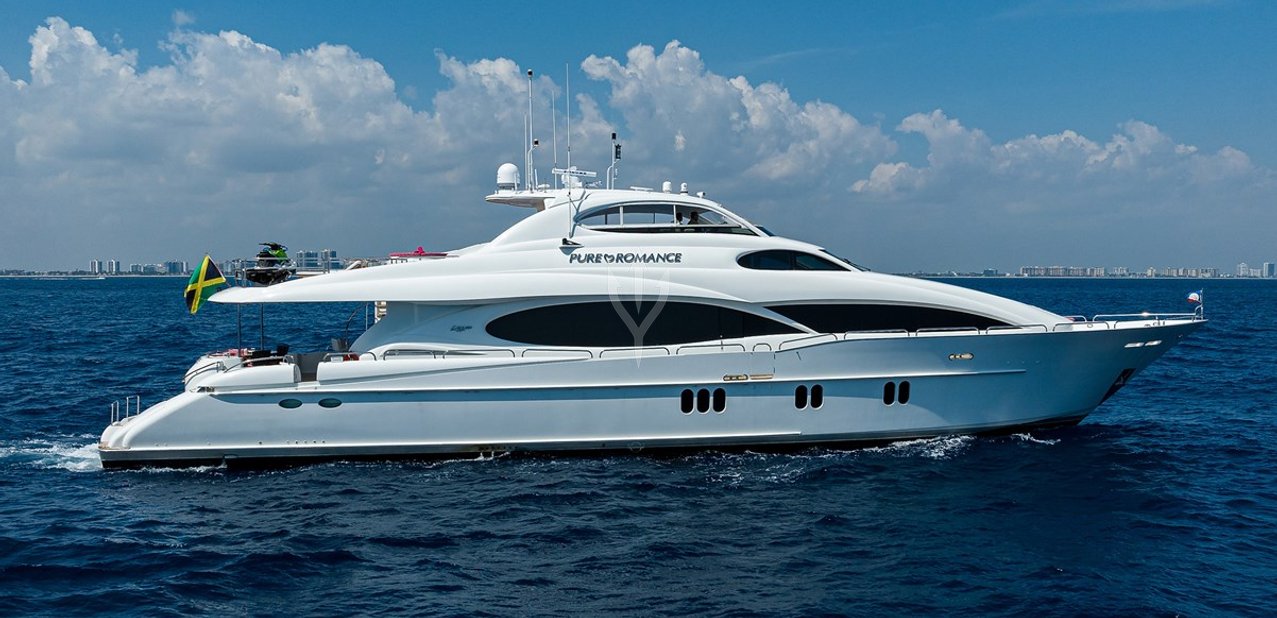
View More Photos
- Luxury Charter Yachts
- Motor Yachts for Charter
The Job Father
- Amenities & Toys
- Rates & Regions
- + Shortlist
THE JOB FATHER YACHT CHARTER
33.53m / 110' lazzara 2007 / 2023.
- Previous Yacht
Special Features:
- Master cabin with dressing room
- Recent refit in 2023
- Sleeps 9 guests
- 9.75m/32' Intrepid Chase Tender
- Able to access shallow bays and coves
Luxury yacht The Job Father combines style, performance and comfort for unforgettable charter vacations
The 33.45m/109'9" 'The Job Father' motor yacht built by shipyard Lazzara is available for charter for up to 9 guests in 4 cabins.
Built in 2007, The Job Father is the ideal luxury yacht for kicking back and relaxing whilst on charter, showcasing clever use of space with an artful combination of integrated systems and luxurious features, she's a crowd-pleaser for sure.
Guest Accommodation
The Job Father offers guest accommodation for up to 9 guests in 4 suites. She is also capable of carrying up to 4 crew onboard to ensure a relaxed luxury yacht charter experience.
Onboard Comfort & Entertainment
Keeping comfortable and entertained on The Job Father is easy thanks to the available amenities such as a deck jacuzzi, perfect to enjoy the scenery with your favourite drink in hand.
Whatever your activities on your charter, you'll find some impressive features are seamlessly integrated to help you such as the underwater lights, adding spectacle and style after dark. With Wi-Fi connectivity you don't have to lose contact with the outside world, unless you want to plus guests will experience complete comfort while chartering thanks to air conditioning.
Performance & Range
Built with a GRP hull and GRP superstructure, she benefits from a semi-displacement hull to provide exceptional seakeeping and impressive speeds. Powered by twin MTU engines, she comfortably cruises at 18 knots, reaches a maximum speed of 27 knots. With a shallow draft of 1.68m/5'6" The Job Father can anchor closer to coves and sheltered bays overnight.
When not cruising The Job Father has onboard an incredible selection of water toys and accessories for you and your guests to connect with the waters around you. Take to the sea on the Jet Skis offering you power and control on the water. You'll be loving the huge adrenaline rush as you zip over the water on one of the Yamaha WaveRunners. The Job Father has a 9.75m/32' Intrepid Chase Tender to transfer you from ship to shore.
Based in the magical waters of the Caribbean all year round The Job Father is ready for your next luxury yacht charter. Let The Job Father Discover the magical places, food and experiences of the the Caribbean.
This luxury motor yacht for charter is in prime condition to host your next holiday of a lifetime.
TESTIMONIALS
There are currently no testimonials for The Job Father, please provide .
The Job Father Photos
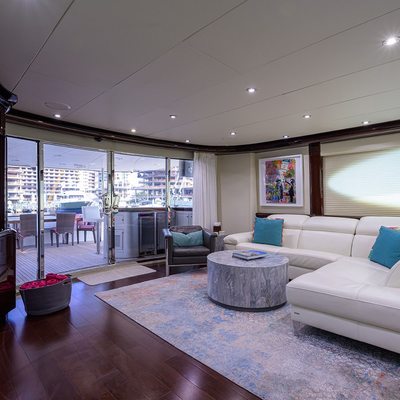
| Length | 33.53m / 110' |
| Beam | 7.04m / 23'1 |
| Draft | 1.68m / 5'6 |
| Gross Tonnage | 211 GT |
| Cruising Speed | 18 Knots |
| Built | | (Refitted) |
| Builder | Lazzara |
| Model | Lazzara 110 |
| Exterior Designer | Lazzara |
Amenities & Entertainment
For your relaxation and entertainment The Job Father has the following facilities, for more details please speak to your yacht charter broker.
The Job Father is reported to be available to Charter with the following recreation facilities:
- 9.75m / 32' Intrepid 32 Chase Tender
For a full list of all available amenities & entertainment facilities, or price to hire additional equipment please contact your broker.
- + shortlist
For a full list of all available amenities & entertainment facilities, or price to hire additional equipment please contact your broker.
'The Job Father' Charter Rates & Destinations
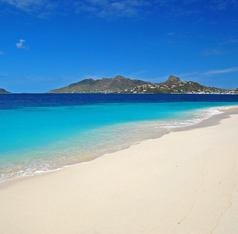
Summer Season
May - September
$85,000 p/week + expenses
High Season
Cruising Regions
Caribbean Bahamas

Winter Season
October - April
$90,000 p/week + expenses
Charter The Job Father
To charter this luxury yacht contact your charter broker , or we can help you.
To charter this luxury yacht contact your charter broker or
Update your yacht
Yacht Owner, Captain or Central Agents - Send us latest Photos, Charter Rates or Corrections Send Updates
SIMILAR YACHTS FOR CHARTER
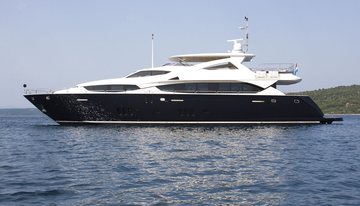
34m | Sunseeker
from $69,000 p/week ♦︎
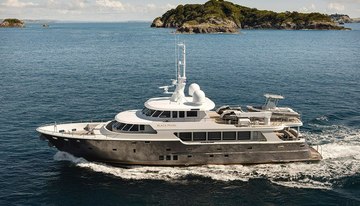
Black Pearl
32m | Diverse Projects
from $69,000 p/week
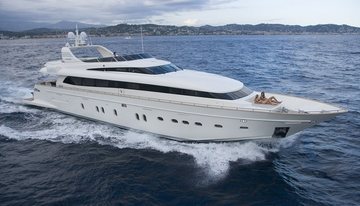
35m | Canados
from $75,000 p/week ♦︎
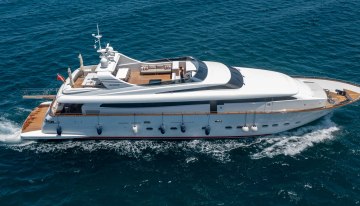
from $98,000 p/week
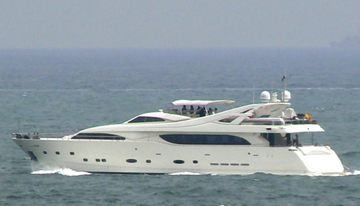
34m | Custom Line
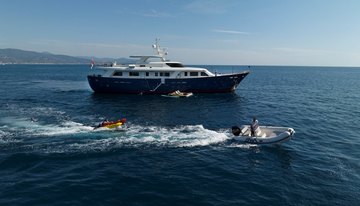
33m | Benetti Sail Division
from $58,000 p/week ♦︎

31m | Custom Line
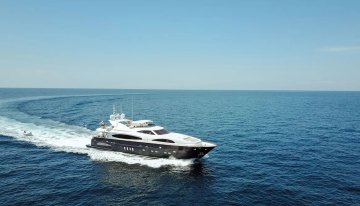
For Your Eyes Only
31m | Astondoa
from $70,500 p/week
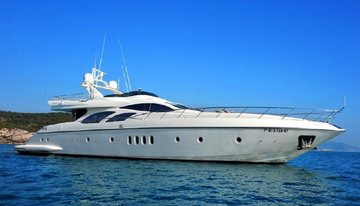
31m | Azimut
from $65,000 p/week
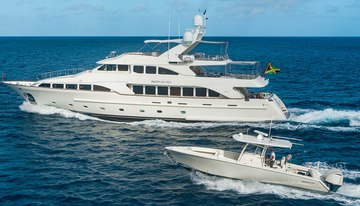
Heaven Can Wait
35m | Benetti
from $85,000 p/week

Honors Legacy
34m | Offshore Yard
from $39,800 p/week
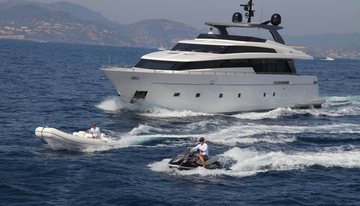
32m | Sanlorenzo
from $86,000 p/week ♦︎
NOTE to U.S. Customs & Border Protection
Specification
SEASONAL CHARTER RATES
- Share on Facebook
- Share Yacht
SIMILAR LUXURY CHARTER YACHTS
Here are a selection of yachts which are similar to the current charter yacht. To view all similar luxury charter yachts click on the button below.
As Featured In
The YachtCharterFleet Difference
YachtCharterFleet makes it easy to find the yacht charter vacation that is right for you. We combine thousands of yacht listings with local destination information, sample itineraries and experiences to deliver the world's most comprehensive yacht charter website.
San Francisco
- Like us on Facebook
- Follow us on Twitter
- Follow us on Instagram
- Find us on LinkedIn
- Add My Yacht
- Affiliates & Partners
Popular Destinations & Events
- St Tropez Yacht Charter
- Monaco Yacht Charter
- St Barts Yacht Charter
- Greece Yacht Charter
- Mykonos Yacht Charter
- Caribbean Yacht Charter
Featured Charter Yachts
- Maltese Falcon Yacht Charter
- Wheels Yacht Charter
- Victorious Yacht Charter
- Andrea Yacht Charter
- Titania Yacht Charter
- Ahpo Yacht Charter
Receive our latest offers, trends and stories direct to your inbox.
Please enter a valid e-mail.
Thanks for subscribing.
Search for Yachts, Destinations, Events, News... everything related to Luxury Yachts for Charter.
Yachts in your shortlist
'Below Deck Sailing Yacht' Star Finally Reveals if Storylines Are Fake

Your changes have been saved
Email is sent
Email has already been sent
Please verify your email address.
You’ve reached your account maximum for followed topics.
Below Deck Sailing Yacht star Gary King is going on the record to clarify that the show is definitely not scripted . The news comes in the middle of rumors surrounding producer plants and fake storylines in the Below Deck franchise . However, after his years of experience as a crew member, the reality star can confirm that the drama is as real as it gets.
King recently took to Instagram and answered some fan questions on his story. One of the questions read: “Do the Below Deck producers tell guests to act crazy or are the guests just crazy?” As a response, King denied the rumors and claimed that all guests on the show were actually just crazy.
Another follower asked the reality star whether the producers influenced the drama on the show. Gary replied with a joke saying: “Yeah, they asked us to crash the boat” before clarifying that he was just kidding and that Below Deck Saling Yacht is a completely unscripted show. The yachting industry veteran clarified that the producers let things play out as they are without telling anyone what to do.
'Below Deck' Has Been Accused of Faking Storylines Previously
According to Below Deck executive producers Mark Cronin and Courtland Cox , fans have a huge misconception about the franchise. Cox believes that the viewers don’t understand how real Below Deck is. She added that as producers, his and Cronin’s job is to stay in the background and let things happen. The producer also claimed that the things that actually happen on the show are too wild for anyone to come up with.
Linda P. Jones , who was a guest on Below Deck Season 6, also went on the record to talk about her experience on the show. She took to her personal website and explained that Below Deck is 100 percent real . Jones also spilled the beans on her one-on-one time with Captain Lee and expressed how fascinating it was to hear his stories and ask him questions. She was also all praises for crew members Kate Chastain and Josiah Carter for their professionalism and the five star service they provided to all the guests.
The former guest talked about her time on the yacht and explained how nerve-wracking it is as guests. Jones confessed that while she avoided going down the slide because she didn’t want to be on camera with her makeup smeared and hair wet. She also shared that none of the guests faced any service problems except one night when they didn’t have any bath towels in their rooms. However, she noted that the moment never made it to the show.
Below Deck Sailing Yacht Season 5 is expected to premiere in Fall 2024. All previous seasons of the show are available to stream on Peacock in the U.S.
Below Deck Sailing Yacht
Not available
In a reality TV series, a crew aboard a luxury sailing yacht navigates the challenges of providing five-star service to affluent guests while managing personal dynamics and the unpredictable nature of the sea. Each episode reveals a blend of high-seas adventure and behind-the-scenes drama among the crew members.
Watch on Peacock

In A Historic First, 2 Chinese Container Ships Cross Paths Just 75 Nautical Miles From The North Pole

MSC Competes with Maersk For Denmark’s Largest Container Port of Aarhus

Watch: Cruise Ship Collides With Large Piece Of Drifting Ice In Alaska

Canadian Coast Guard Acquires Its First-Ever Autonomous Surface Vessel

Late Steve Job’s Super Yacht Venus
As inspiring and revolutionary Steve Jobs’ engineering concept is, equally brilliant is the late innovator’s mega yacht named Venus. Having commissioned the vessel even before the diagnosis of his terminal illness, Jobs intended the vessel to be his swan-song , after his terminal health problem was brought to light. According to the reports, the mega yacht was put into operation in 2012, a year after Jobs’ untimely demise.
The designing concept of the vessel was carried out mainly by reputed French marine architect Philippe Starck with several noteworthy inputs provided by Jobs himself. However for a brief period, the designing of the vessel was almost stalled by the American tycoon on account of the state of his health, though he later resumed it as a way of ensuring that his legacy and presence was carried forth even in his absence.
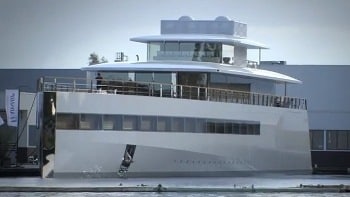
Feadship is known world-wide as a specialist in building one-of-a-kind super yachts.
With regard to Venus, it has provided the following technical uniqueness:
- A stream-lined aluminium hull that replicates the visual effect of the Apple gadgetries
- State-of-the-art technological inclusions like incorporation of iMac systems to allow for superior manoeuvring on water
- Ultra-modern accommodation amenities
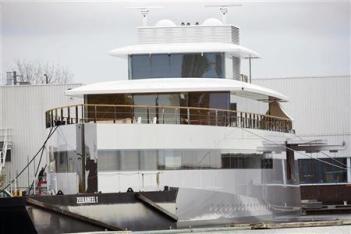
Controversy about Payment
Almost immediately after the mega yacht was launched, there was a slight controversy surrounding the Venus. Principle designer Philippe Starck alleged that the legal inheritors of the yacht had failed to pay the balance of his dues, amounting to around US$ four million. Following the allegation, the yacht was seized at the Rotterdam harbor before the defaulted dues were paid and settled by the late entrepreneur’s legal team on behalf of the inheritors.
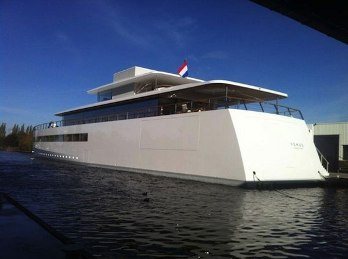
The mega yacht was named for the Greco-Roman Goddess of romance, Venus and it was with great love that Steve Jobs envisioned its completion. Although unfortunately he was unable to see his vision brought to life, yacht Venus holds one lasting memory of Jobs to his loved and cherished ones.
Video of Superyacht Venus
You may also like to read:- The Awe-Inspiring Adastra Superyacht
Disclaimer : The information contained in this website is for general information purposes only. While we endeavour to keep the information up to date and correct, we make no representations or warranties of any kind, express or implied, about the completeness, accuracy, reliability, suitability or availability with respect to the website or the information, products, services, or related graphics contained on the website for any purpose. Any reliance you place on such information is therefore strictly at your own risk.
In no event will we be liable for any loss or damage including without limitation, indirect or consequential loss or damage, or any loss or damage whatsoever arising from loss of data or profits arising out of, or in connection with, the use of this website.

Do you have info to share with us ? Suggest a correction
Daily Maritime News, Straight To Your Inbox
Sign Up To Get Daily Newsletters
Join over 60k+ people who read our daily newsletters
By subscribing, you agree to our Privacy Policy and may receive occasional deal communications; you can unsubscribe anytime.

BE THE FIRST TO COMMENT
Leave a reply.
Your email address will not be published. Required fields are marked *
Subscribe to Marine Insight Daily Newsletter
" * " indicates required fields
Marine Engineering
Marine Engine Air Compressor Marine Boiler Oily Water Separator Marine Electrical Ship Generator Ship Stabilizer
Nautical Science
Mooring Bridge Watchkeeping Ship Manoeuvring Nautical Charts Anchoring Nautical Equipment Shipboard Guidelines
Explore
Free Maritime eBooks Premium Maritime eBooks Marine Safety Financial Planning Marine Careers Maritime Law Ship Dry Dock
Shipping News Maritime Reports Videos Maritime Piracy Offshore Safety Of Life At Sea (SOLAS) MARPOL
CAREER TOOLS

INTERVIEWING TIPS

RELOCATION ASSISTANCE

RESUME HELP

SALARY ADVICE
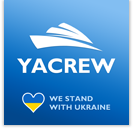
Yacht Crew Positions and Salaries
The organisational structure onboard a superyacht follows a strong hierarchy based upon a military model. Exact job duties and lines of authority are set and strictly adhered to. This hierarchy is followed on the vast majority of yachts; however, responsibilities of the crew on smaller yachts are often merged.
There are four departments on yachts with clear organisational structure:
- Deck (including Bridge) – Safety, passage delivery, maintenance of the yacht's exterior, guest outdoor activities
- Engineering – Safety and smooth operational running of the yacht
- Interior – Housekeeping, guest wellbeing, activities, accounting
- Galley – Food preparation, stock control, hygiene, galley maintenance
The top of the hierarchy on each yacht is the Captain , who reports to the yacht owner either directly, or through a representative or a yacht management company.
Salaries vary and depend on the yacht size, use, type and location, as well as the experience and qualification of the crew member. We included typical salaries of crew based on the data available from reputable industry sources, as well as our research of over 60,000 crew registered with us.
Deck Positions
The primary duty of the Captain is the overall safe manning and operation of the yacht. Yacht Captain is responsible for the vessel, yacht crew, owner and guests, including personnel management, shipyard/project management, legal and regulatory compliance, accounting, achieving owners' objectives, and answers to the owner regarding all decisions.
| Captain | €4,000 - €15,000 |
First Mate / Chief Officer
The First Mate or Chief Officer is the right hand of the Captain. Takes command of the yacht from Captain when required. Shares Captain's responsibilities as required.
| Chief Officer | €3,000 - €13,500 |
| 2nd Officer | €3,000 - €8,000 |
| 3rd Officer | €2,500 - €6,000 |
| Security Officer | €3,000 - €5,000 |

Bosun / Lead Deckhand
Bosuns are usually experienced Deckhands with additional responsibilities. They are in charge of Deckhands onboard the yacht and often spend a lot of time with guests during outdoor activities. The Bosun is normally the main tender driver.
| Mate | €2,500 - €6,000 |
| Bosun | €2,500 - €5,500 |
| Lead Deckhand | €2,500 - €5,000 |
Responsible for the maintenance of the exterior of the yacht and keeping it in pristine condition at all times. Deckhands also assist in maintaining, cleaning and operating yacht's tenders.
| Junior Deckhand | €2,000 - €3,000 |
| Carpenter | €3,000 - €4,000 |
Engineering Positions
Chief engineer.
Responsible for the Engineering Department and for all technical aspects of the boat and its equipment. The Chief Engineer's duties include overseeing all mechanical and electrical operations, ensuring all planned maintenance takes place and liaising with subcontractors.
| Chief Engineer | €5,000 - €15,000 |
Second / Third Engineer
The Second and Third Engineers report directly to the Chief Engineer. They assist in maintaining all mechanical and electrical operations of the yacht.
| 2nd Engineer | €3,000 - €10,000 |
| 3rd Engineer | €2,500 - €6,500 |
| Sole Engineer | €3,500 - €12,000 |
| Motorman | €2,500 - €4,000 |
ETO / AV/IT Officer
Electro-Technical Officer (ETO) and AV/IT Officer are in charge of daily maintenance of all electronic, computer, audio/visual and communications equipment and their efficient operation. This includes the radio, radar, telephones, satellite communications, navigation systems, computers, Internet connection, interior equipment (TVs, sound systems), etc.
| ETO | €4,000 - €8,000 |
| AV/IT Officer | €4,000 - €7,000 |
Electrician
The Electrician is responsible for maintenance of all electrical circuits onboard the vessel, circuit breakers, switches, lighting, batteries, etc.
| Electrician | €4,000 - €6,500 |
This is an administrative position on large yachts. The Purser is responsible for all operations in the interior department, including inventory, purchasing, provisioning, accounting, organising guest activities, and assisting the Captain with the yachts paperwork.
| Purser | €5,000 - €9,000 |
Chief Steward(ess)
Duties are similar to those of other Steward(ess)es onboard the boat, but on a more senior level, including managing the interior department and training. Small yachts with less crew do not have a Purser. The Chief Steward(ess) is in charge of all the responsibilities normally carried out by the Purser on large yachts.
| Chief Steward(ess) | €4,500 - €8,500 |
| Interior Manager | €4,000 - €8,000 |
| Head of Servicer | €4,000 - €7,000 |
| Head Housekeeper | €3,000 - €5,500 |
| Spa Manager | €3,500 - €5,500 |
Steward(ess)
Steward's or Stewardess's main responsibility is to maintain the interior of the yacht and provide the highest standard of care to the owner and guests. They serve food and drinks, prepare guest activities, pack and unpack luggage and are on call for anything that the guests want anytime day or night. On some yachts, they help the deck crew moor the yacht.
| 2nd Steward(ess) | €3,000 - €6,500 |
| 3rd Steward(ess) | €2,500 - €4,000 |
| Spa Steward(ess) | €3,000 - €4,000 |
| Service Steward(ess) | €2,500 - €5,000 |
| Housekeeping Steward(ess) | €2,500 - €4,000 |
| Laundry Steward(ess) | €2,500 - €4,000 |
| Sole Steward(ess) | €3,000 - €6,000 |
| Junior Steward(ess) | €2,000 - €3,500 |
| Butler | €3,500 - €6,000 |
| Stew/Deck | €2,500 - €4,000 |
The Head/Executive Chef onboard a luxury superyacht is a culinary trained professional responsible for the overall management of the galley department on larger yachts, including guest and crew meals, provisioning, food safety, maintaining strict hygiene standards and financial/budgetary administration.
| Head Chef | €6,000 - €10,000 |
Assists the Head Chef in all aspects of galley duties. The Sous Chef may be required to independently provide crew meals or guest meals at the direction of the Head Chef.
| Sous Chef | €3,500 - €8,000 |
Crew Chef / Cook
Large yachts employ a separate crew and guest chef. The Crew chef provides meals for the crew.
| Crew Chef / Cook | €3,000 - €5,000 |
| Sole Chef | €3,500 - €9,000 |
| Stew / Cook | €2,000 - €4,500 |
Other Positions
Many yachts, especially the large ones, have several additional positions. These are often combined with primary roles, e.g. Stewardess / Masseuse or Deckhand / Dive Instructor . The most common are:
| Beautician | €3,000 - €4,000 |
| Hairdresser | €3,000 - €4,000 |
| Massage Therapist | €2,000 - €4,500 |
| Nurse | €3,000 - €4,500 |
| Dive Instructor | €3,000 - €6,000 |
Career Advice:
Email address:
Remember me Forgotten password?
Password Reset
Enter your email address and we will email you a password reset link.
Email address:

The global authority in superyachting
- NEWSLETTERS
- Yachts Home
- The Superyacht Directory
- Yacht Reports
- Brokerage News
- The largest yachts in the world
- The Register
- Yacht Advice
- Yacht Design
- 12m to 24m yachts
- Monaco Yacht Show
- Builder Directory
- Designer Directory
- Interior Design Directory
- Naval Architect Directory
- Yachts for sale home
- Motor yachts
- Sailing yachts
- Explorer yachts
- Classic yachts
- Sale Broker Directory
- Charter Home
- Yachts for Charter
- Charter Destinations
- Charter Broker Directory
- Destinations Home
- Mediterranean
- South Pacific
- Rest of the World
- Boat Life Home
- Owners' Experiences
- Conservation and Philanthropy
- Interiors Suppliers
- Owners' Club
- Captains' Club
- BOAT Showcase
- Boat Presents
- Events Home
- World Superyacht Awards
- Superyacht Design Festival
- Design and Innovation Awards
- Young Designer of the Year Award
- Artistry and Craft Awards
- Explorer Yachts Summit
- Ocean Talks
- The Ocean Awards
- BOAT Connect
- Between the bays
- Golf Invitational
- BOATPro Home
- Superyacht Insight
- Global Order Book
- Premium Content
- Product Features
- Testimonials
- Pricing Plan
- Tenders & Equipment
Follow in the wake of Venus: 9 destinations visited by Steve Jobs' yacht
The late Steve Jobs’ superyacht Venus has been making her way around Turkey and the Greek islands over the past two weeks. The 78 metre Feadship Venus is now owned by Steve Jobs’ widow, Laurene Powell Jobs, and is not available for charter . Luxury yacht Venus was commissioned by the late founder of Apple, Steve Jobs, in 2008 and continues to turn heads wherever she docks.
Here are nine of the destinations Venus has visited while cruising along Turkey’s Turquoise Coast and the Greek Islands.
After cruising across from Majorca, the late Steve Job’s luxury yacht Venus ’ first stop in Turkey was at Fethiye, a common starting point for a private vacation or luxury yacht charters in Turkey .
Fethiye is located on the site of the ancient city of Telmessos and in 1958 an earthquake destroyed almost all of the town. More than 50 years later the city has now recovered and it a bustling centre of the Western Mediterranean.
The huge bay offers good protection from prevailing winds if you want to anchor out. Alternatively, Ece Marina can accommodate yachts up to 60 metres.
From Fethyiye Venus then cruised the 11 nautical miles to Göcek. The heart of yacht tourism in the area Göcek is starting to regularly attract some of the world’s largest yachts .
The area boasts plenty of coves and beaches, which are great for watersports. There are also a host of ancient cities within an hour’s drive of Göcek.
Göcek has three marinas that can accommodate yachts up to 70 metres. If you are looking for high-end luxury D-Marin Göcek can now accommodate yachts up to 75 metres. It has a white sand beach and is situated next to luxury resort hotel D-Resort. For a central location Skopea marina is within walking distance of the town’s facilities and also has a semi-Olympic sized swimming pool. Alternatively for a quieter setting, Club Marina is only a five-minute walk away from Göcek and offers beautiful natural scenery.
Picture courtesy of Lukash Dmitry/Shutterstock.com
Bozburun peninsula
Venus went on to spend three days exploring Marmaris and the Bozburun peninsula. Marmaris is a tourist hotspot with a waterfront offering host of restaurants. Heading down the coast from Marmaris you are treated to a taste of real turkey. Even during the peak summer period the area remains relatively quiet and offers you the chance to step back in time.
There are no superyacht marinas on the peninsula but, as Venus did, there are plenty of secluded places in which to anchor overnight.
PIcture courtesy of Nejdet Duzen/Shutterstock.com
From the Bozburun peninsula Venus cruised across into Greek waters. Despite the current economical issues and a VAT increase on luxury yacht charters brokers are keen to impress that is still “business as usual” in the country.
Venus visited Milos, the southwestern most island in the Cyclades, which offers more than 75 beaches with crystal blue waters. Because Milos is volcanic is has spectacular rock formations as well as hot springs and stunning cliffs.
You are best to anchor off the island and then tender in to explore further. Milos can also be used as a stop off destination when returning to Athens after exploring the Cyclades Islands on a superyacht .
Picture courtesy of Leoks/Shutterstock.com
From Milos Venus next went on to anchor off Paros. Located at the heart of the Cyclades islands Paros is a popular tourist destination and has traditional whitewashed villages and stunning cliff paths to hike along. Naoussa on the northeaster side of the island has a fishing harbour and also has a small selection of clubs if you fancy letting your hair down.
There are a variety of different secluded anchorages to choose from around the island.
Picture courtesy of Haris Vythoulkas/Shutterstock.com
Superyacht Venus then travelled on to the Greek Island of Samos, which is famous for its vineyards that produce samiotiko wine. The island was home to ancient philosopher and mathematician Pythagoras, the astronomer Aristarchus and the philosopher Epicurus. When Venus anchored off the coast of Samos she attracted attention from a host of locals and tourist.
If you are looking for a marina on the Southeast side of the island Samos Marina can berth yachts up to 50 metres.
Picture courtesy of Evantravels/Shutterstock.com
From the Greek islands Venus then cruised back across to Kuşadası on the Turkish coast. The town has Turkey’s busiest cruised port and is the coastal gateway to Ephesus.
Kuşadasi Marina can accommodate yachts up to 70 metres in length and offers top quality facilities. Venus only had a short in Kuşadası before heading up the coast.
Picture courtesy of Worradirek/Shutterstock.com
Superyacht Venus then headed up to the seaside town of Ayvalık. The town has interesting architecture with a host of churches and monasteries. The busiest area of the town is the harbour where fishing boats and sightseeing trips are regularly anchored. Ayvalik Marina has 200 berths and can host superyachts up to 40 metres. The marina also offers extensive repair and maintenance services.
Picture courtesy of Yulia GursoyShutterstock.com
Venus then made her way up to the cultural melting point of Istanbul. Sitting astride the Bosphorus the city straddles Europe and Asia and is a popular start or finish destination for private cruises or luxury yacht charters in Turkey . The iconic city is home to numerous interesting buildings and tourist attractions and is also one of many James Bond locations to visit on a superyacht .
Kalamis and Fenerbahçe marinas are situated next to each five miles east of the city centre and are a good location from which to explore the city. They can both accommodate yachts up to 60 metres and have restaurants, shops and a swimming pool.
Picture courtesy of Sj Travel Photo And Video/Shutterstock.com
Sponsored listings
Once impounded for lack of payments, Steve Jobs’ $140 million luxury yacht Venus is an avant-garde 256-ft long cruiser. It has 40-feet floor-to-ceiling windows and its glass is created by the designer of Apple stores.

You may also like
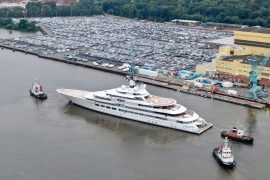
Who owns this $700 million megayacht? European authorities are struggling to find the owner of this 460 feet long vessel that has two helipads, a large pool, and four fabulous decks.
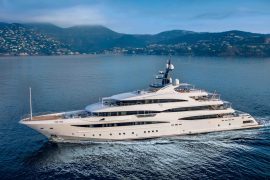
Star Wars loving Australian billionaire is selling his superyacht for $167 million. The VIP suite on the 243 feet long vessel is named ‘Master Yoda’. Designed with a focus on family, it has a gym that transforms into a classroom for children, an espresso bar, and a large swimming pool.
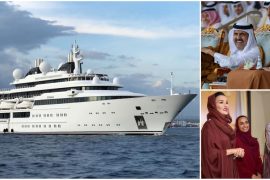
Longer than a FIFA soccer field, the Qatari royal family’s yacht is so big that it can be mistaken for a cruise ship – The $400 million vessel is built for utmost comfort and privacy, its unique stabilization system offers a smooth journey even in rough seas.

This sanctioned Russian billionaire banker is suing the French government after customs agents boarded and immobilized his two superyachts
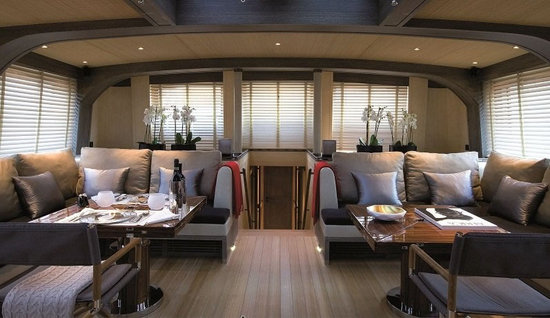
The spacious 46.8 meter superyacht Roxane helps to get adventurous in the water

Marc Anthony’s 120 foot $7 million yacht capsizes after catching on fire in Miami
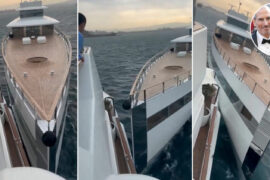
Despite using state-of-the-art iMacs for navigation, Steve Jobs’ 260-foot superyacht Venus rammed into a Mexican billionaire’s $250 million superyacht in broad daylight.
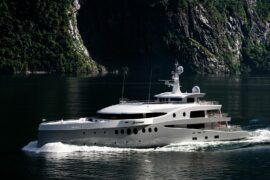
Stardust is a $200 million superyacht that exudes splendor with its unique 206-foot exterior

A new way to high-seas luxury, onboard the megayacht Espresso
- Feb 21, 2021
- 20 min read
The Dyatlov Pass Incident
What is the Dyatlov Pass incident? Well, as we’ll find out, it was when nine Russian hikers died in the northern Ural Mountains between February 1st & 2nd in 1959, under supposed uncertain circumstances. The experienced trekking group, who were all from the Ural Polytechnical Institute , had established a camp on the slopes of Kholat Syakhl , in an area now named in honour of the group's leader, Igor Dyatlov. During the night, something caused them to cut their way out of their tent and attempt to flee the campsite while not being dressed for the heavy ass snowfall and subzero temperatures. Subzero was one of my favorite Mortal Kombat characters… god I loved that game.
After the group's bodies were grusomly discovered, an investigation by Soviet authorities determined that six of them had died from hypothermia while the other three had been killed by physical trauma . One victim actually had major skull damage, two had severe chest trauma, and another had a small crack in the skull . Was all of this caused by an avalanche or from something nefarious? Four of the bodies were found lying in running water in a creek, and three of these had soft tissue damage of the head and face – two of the bodies were missing their eyes, one was missing its tongue, and one was missing its eyebrows. It’s eyebrows! The Soviet investigation concluded that a "compelling natural force" had caused the untimely deaths. Numerous theories have been brought forward to account for the unexplained deaths, including animal attacks, hypothermia, avalanche , katabatic winds , infrasound -induced panic, military involvement, or some combination of these. We’ll discuss all these in further detail later on.
Recently, Russia has opened a new investigation into the Dyatlov incident in 2019, and its conclusions were presented in July 2020: Simply put, they believe that an avalanche had led to the deaths of the hikers. Survivors of the avalanche had been forced to suddenly leave their camp in low visibility conditions with inadequate clothing, and had died of hypothermia. Andrey Kuryakov, deputy head of the regional prosecutor's office, said: "It was a heroic struggle. There was no panic. But they had no chance to save themselves under the circumstances." A study published in 2021 suggested that a type of avalanche known as a slab avalanche could explain some of the injuries. However, we’ll run through everything and you can come to your own conclusion.
Ok, let’s dive into the details of the event.
In 1959, the group was formed for a skiing expedition across the northern Urals in Sverdlovsk Oblast, Soviet Union. According to Prosecutor Tempalov, documents that were found in the tent of the expedition suggest that the expedition was named for the 21st Congress of the Communist Party of the Soviet Union, and was possibly dispatched by the local Komsomol organisation.Which was a political youth organization in the Soviet Union , which was sometimes described as the youth division of the Communist Party of the Soviet Union . Igor Dyatlov, a 23-year-old radio engineering student at the Ural Polytechnical Institute; now Ural Federal University, was the leader who assembled a group of nine others for the trip, most of whom were fellow students and peers at the university.Ok, so they were mostly students. Each member of the group, which consisted of eight men and two women, was an experienced Grade II-hiker with ski tour experience, and would be receiving Grade III certification upon their return. So, this trekk was like a test. I hated tests. Especially ones that could KILL YOU! At the time, this was the highest certification available in the Soviet Union, and required candidates to traverse 190 mi. The route was designed by Igor Dyatlov's group in order to reach the far northern regions of Sverdlovsk Oblast and the upper-streams of the Lozva river. The route was approved by the Sverdlovsk city route commission, which was a division of the Sverdlovsk Committee of Physical Culture and Sport. They approved of and confirmed the group of 10 people on January 8th, 1959. The goal of the expedition was to reach Otorten, a mountain(6.2 mi north of the site where the incident took place. This path, taken in February, was estimated as a Category III, the most difficult time to traverse.
On January 23rd, 1959 the Dyatlov group was issued their route book which listed their course as following the No.5 trail. At that time, the Sverdlovsk City Committee of Physical Culture and Sport listed approval for 11 people. The 11th person was listed as Semyon Zolotaryov who was previously certified to go with another expedition of similar difficulty (that was the Sogrin expedition group). The Dyatlov group left the Sverdlovsk city (today called Yekaterinburg) on the same day they received the route book.
The members of the group were Igor Alekseyevich Dyatlov, Yuri Nikolayevich Doroshenko, Lyudmila Alexandrovna Dubinina, Georgiy (Yuri) Alexeyevich Krivonischenko, Alexander Sergeyevich Kolevatov, Zinaida Alekseevna Kolmogorova, Rustem Vladimirovich Slobodin, Nikolai Vladimirovich Thibeaux-Brignolles, Semyon (Alexander) Alekseevich Zolotaryov, and Yuri Yefimovich Yudin
The group arrived by train at Ivdel , a town at the centre of the northern province of Sverdlovsk Oblast in the early morning hours of January 25, 1959. They took a truck to Vizhai, a little village that is the last inhabited settlement to the north. As of 2010, only 207 really, really fucking cold people lived there. While spending the night in Vizhai, and probably freezing their baguettes off, the skiers purchased and ate loaves of bread to keep their energy levels up for the following day's hike.
On January 27, they began their trek toward Gora Otorten. On January 28, one member, Yuri Yudin, who suffered from several health ailments (including rheumatism and a congenital heart defect ) turned back due to knee and joint pain that made him unable to continue the hike. The remaining nine hikers continued the trek. Ok, my first question with this is, why in the fuck was that guy there, to begin with??
Diaries and cameras found around their last campsite made it possible to track the group's route up to the day before the incident. On January 31st, the group arrived at the edge of a highland area and began to prepare for climbing. In a wooded valley, they rounded up surplus food and equipment that they would use for the trip back. The next day, the hikers started to move through the pass. It seems they planned to get over the pass and make camp for the next night on the opposite side, but because of worsening weather conditions—like snowstorms, decreasing visibility... large piles of yeti shit—they lost their direction and headed west, toward the top of Kholat Syakhl . When they realised their mistake, the group decided to set up camp there on the slope of the mountain, rather than move almost a mile downhill to a forested area that would have offered some shelter from the weather. Yudin, the debilitated goofball that shouldn’t have even been there speculated, "Dyatlov probably did not want to lose the altitude they had gained, or he decided to practice camping on the mountain slope."
Before leaving, Captain Dyatlov had agreed he would send a telegram to their sports club as soon as the group returned to teeny, tiny Vizhai. It was expected that this would happen no later than February 12th, but Dyatlov had told Yudin, before he departed from the group, that he expected it to actually be longer. When the 12th passed and no messages had been received, there was no immediate reaction because, ya know… fuck it. Just kidding, these types of delays were actually common with such expeditions. On February 20th, the travellers' worried relatives demanded a rescue operation and the head of the institute sent the first rescue groups, consisting of volunteer students and teachers. Later, the army and militsiya forces (aka the Soviet police) became involved, with planes and helicopters ordered to join in on the search party.
On February 26th, the searchers found the group's abandoned and super fucked up tent on Kholat Syakhl . The campsite undoubtedly baffled the search party. Mikhail Sharavin, the student who found the tent, said “HOLY SHIT! THIS PLACE IS FUCKED UP!”... No, that’s not true. He actually said, "the tent was half torn down and covered with snow. It was empty, and all the group's belongings and shoes had been left behind." Investigators said the tent had been cut open from inside. Which seems like a serious and quick escape route was needed. Nine sets of footprints, left by people wearing only socks or a single shoe or even barefoot, could actually be followed, leading down to the edge of a nearby wood, on the opposite side of the pass, about a mile to the north-east. After approximately 1,600 ft, these tracks were covered with snow. At the forest's edge, under a large Siberian pine , the searchers found the visible remains of a small fire. There were the first two bodies, those of Krivonischenko and Doroshenko, shoeless and dressed only in their tighty whiteys. The branches on the tree were broken up to five meters high, suggesting that one of the skiers had climbed up to look for something, maybe the camp. Between the pine and the camp, the searchers found three more corpses: Dyatlov, Kolmogorova, and Slobodin, who died in poses suggesting that they were attempting to return to the tent. They were found at distances of 980, 1,570, and 2,070 ft from the tree.
Finding the remaining four travellers took more than two frigging months. They were finally found on May 4th under 13 ft of snow in a ravine 246 ft further into the woods from the pine tree. Three of the four were better dressed than the others, and there were signs that some clothing of those who had died first had been taken off of their corpses for use by the others. Dubinina was wearing Krivonishenko's burned, torn trousers, and her left foot and shin were wrapped in a torn jacket.
Let’s get into the investigation. A legal inquest started immediately after the first five bodies were found. A medical examination found no injuries that might have led to their deaths, and it was concluded that they had all died of hypothermia .Which would make sense because it was colder than a polar bear’s butthole. Slobodin had a small crack in his skull, but it was not thought to be a fatal wound.
An examination of the four bodies found in May shifted the overall narrative of what they initially believed transpired. Three of the hikers had fatal injuries: Thibeaux-Brignolles had major skull damage, and Dubinina and Zolotaryov had major chest fractures. According to Boris Vozrozhdenny, the force required to cause such damage would have been extremely high, comparable to that of a car crash.Also, the bodies had no external wounds associated with the bone fractures, as if they had been subjected to a high level of pressure.
All four bodies found at the bottom of the creek in a running stream of water had soft tissue damage to their head and face. For example, Dubinina was missing her tongue, eyes, part of the lips, as well as facial tissue and a fragment of her skullbone, while Zolotaryov was missing his friggin eyeballs, and Aleksander Kolevatov his eyebrows. V. A. Vozrozhdenny, the forensic expert performing the post-mortem examination , judged that these injuries happened after they had died, due to the location of the bodies in a stream.
At first, there was speculation that the indigenous Mansi people , who were just simple reindeer herders local to the area, had attacked and murdered the group for making fun of Rudolph. Several Mansi were interrogated, but the investigation indicated that the nature of the deaths did not support this hypothesis: only the hikers' footprints were visible, and they showed no sign of hand-to-hand struggle. Oh, I was kidding about the Rudolph thing. They thought they attacked the hikers for being on their land.
Although the temperature was very low, around −13 to −22 °F with a storm blowing, the dead were only partially dressed, as I mentioned.
Journalists reporting on the available parts of the inquest files claim that it states:
Six of the group members died of hypothermia and three of fatal injuries.
There were no indications of other people nearby on Kholat Syakhl apart from the nine travellers.
The tent had been ripped open from within.
The victims had died six to eight hours after their last meal.
Traces from the camp showed that all group members left the campsite of their own accord, on foot.
Some levels of radiation were found on one victim's clothing.
To dispel the theory of an attack by the indigenous Mansi people, Vozrozhdenny stated that the fatal injuries of the three bodies could not have been caused by human beings, "because the force of the blows had been too strong and no soft tissue had been damaged".
Released documents contained no information about the condition of the skiers' internal organs.
And most obviously, There were no survivors.
At the time, the official conclusion was that the group members had died because of a compelling natural force.The inquest officially ceased in May 1959 as a result of the absence of a guilty party. The files were sent to a secret archive.
In 1997, it was revealed that the negatives from Krivonischenko's camera were kept in the private archive of one of the investigators, Lev Ivanov. The film material was donated by Ivanov's daughter to the Dyatlov Foundation. The diaries of the hiking party fell into Russia's public domain in 2009.
On April 12th, 2018, Zolotarev's remains were exhumed on the initiative of journalists of the Russian tabloid newspaper Komsomolskaya Pravda . Contradictory results were obtained: one of the experts said that the character of the injuries resembled a person knocked down by a car, and the DNA analysis did not reveal any similarity to the DNA of living relatives. In addition, it turned out that Zolotarev's name was not on the list of those buried at the Ivanovskoye cemetery. Nevertheless, the reconstruction of the face from the exhumed skull matched postwar photographs of Zolotarev, although journalists expressed suspicions that another person was hiding under Zolotarev's name after World War II .
In February 2019, Russian authorities reopened the investigation into the incident, yet again, although only three possible explanations were being considered: an avalanche, a slab avalanche , or a hurricane . The possibility of a crime had been discounted.
Other reports brought about a whole bunch of additional speculation.
Twelve-year-old Yury Kuntsevich, who later became the head of the Yekaterinburg-based Dyatlov Foundation, attended five of the hikers' funerals. He recalled that their skin had a "deep brown tan".
Another group of hikers 31 mi south of the incident reported that they saw strange orange spheres in the sky to the north on the night of the incident.Similar spheres were observed in Ivdel and other areas continually during the period from February to March of 1959, by various independent witnesses (including the meteorology service and the military). These sightings were not noted in the 1959 investigation, and the various witnesses came forward years later.
After the initial investigation,
Anatoly Gushchin summarized his research in the book The Price of State Secrets Is Nine Lives. Some researchers criticised the work for its concentration on the speculative theory of a Soviet secret weapon experiment, but its publication led to public discussion, stimulated by interest in the paranormal .It is true that many of those who had remained silent for thirty years reported new facts about the accident. One of them was the former police officer, Lev Ivanov, who led the official inquest in 1959. In 1990, he published an article that included his admission that the investigation team had no rational explanation for the incident. He also stated that, after his team reported that they had seen flying spheres, he then received direct orders from high-ranking regional officials to dismiss this claim.
In 2000, a regional television company produced the documentary film The Mystery of Dyatlov Pass . With the help of the film crew, a Yekaterinburg writer, Anna Matveyeva, published a docudrama of the same name. A large part of the book includes broad quotations from the official case, diaries of victims, interviews with searchers and other documentaries collected by the film-makers. The narrative line of the book details the everyday life and thoughts of a modern woman (an alter ego of the author herself, which is super weird) who attempts to resolve the case. Despite its fictional narrative, Matveyeva's book remains the largest source of documentary materials ever made available to the public regarding the incident. Also, the pages of the case files and other documentaries (in photocopies and transcripts) are gradually being published on a web forum for nerds just like you and i!.
The Dyatlov Foundation was founded in 1999 at Yekaterinburg, with the help of Ural State Technical University, led by Yuri Kuntsevitch. The foundation's stated aim is to continue investigation of the case and to maintain the Dyatlov Museum to preserve the memory of the dead hikers. On July 1st 2016, a memorial plaque was inaugurated in Solikamsk in Ural's Perm Region, dedicated to Yuri Yudin (the dude who pussed out and is the sole survivor of the expedition group), who died in 2013.
Now, let’s go over some of the theories of what actually took place at the pass.
On July 11 2020, Andrey Kuryakov, deputy head of the Urals Federal District directorate of the Prosecutor-General 's Office, announced an avalanche to be the "official cause of death" for the Dyatlov group in 1959. Later independent computer simulation and analysis by Swiss researchers also suggest avalanche as the cause.
Reviewing the sensationalist " Yeti " hypothesis , American skeptic author Benjamin Radford suggests an avalanche as more plausible:
“that the group woke up in a panic (...) and cut their way out the tent either because an avalanche had covered the entrance to their tent or because they were scared that an avalanche was imminent (...) (better to have a potentially repairable slit in a tent than risk being buried alive in it under tons of snow). They were poorly clothed because they had been sleeping, and ran to the safety of the nearby woods where trees would help slow oncoming snow. In the darkness of night, they got separated into two or three groups; one group made a fire (hence the burned hands) while the others tried to return to the tent to recover their clothing since the danger had passed. But it was too cold, and they all froze to death before they could locate their tent in the darkness. At some point, some of the clothes may have been recovered or swapped from the dead, but at any rate, the group of four whose bodies was most severely damaged were caught in an avalanche and buried under 4 meters (13 ft) of snow (more than enough to account for the 'compelling natural force' the medical examiner described). Dubinina's tongue was likely removed by scavengers and ordinary predation.”
Evidence contradicting the avalanche theory includes:
The location of the incident did not have any obvious signs of an avalanche having taken place. An avalanche would have left certain patterns and debris distributed over a wide area. The bodies found within a month of the event were covered with a very shallow layer of snow and, had there been an avalanche of sufficient strength to sweep away the second party, these bodies would have been swept away as well; this would have caused more serious and different injuries in the process and would have damaged the tree line.
Over 100 expeditions to the region had been held since the incident, and none of them ever reported conditions that might create an avalanche. A study of the area using up-to-date terrain-related physics revealed that the location was entirely unlikely for such an avalanche to have occurred. The "dangerous conditions" found in another nearby area (which had significantly steeper slopes and cornices) were observed in April and May when the snowfalls of winter were melting. During February, when the incident occurred, there were no such conditions.
An analysis of the terrain and the slope showed that even if there could have been a very specific avalanche that found its way into the area, its path would have gone past the tent. The tent had collapsed from the side but not in a horizontal direction.
Dyatlov was an experienced skier and the much older Zolotaryov was studying for his Masters Certificate in ski instruction and mountain hiking. Neither of these two men would have been likely to camp anywhere in the path of a potential avalanche.
Footprint patterns leading away from the tent were inconsistent with someone, let alone a group of nine people, running in panic from either real or imagined danger. All the footprints leading away from the tent and towards the woods were consistent with individuals who were walking at a normal pace.
Repeated 2015 investigation [ edit ]
A review of the 1959 investigation's evidence completed in 2015–2019 by experienced investigators from the Investigative Committee of the Russian Federation (ICRF) on request of the families confirmed the avalanche with several important details added. First of all, the ICRF investigators (one of them an experienced alpinist ) confirmed that the weather on the night of the tragedy was very harsh, with wind speeds up to hurricane force,(45–67 mph, a snowstorm and temperatures reaching −40 °C. These factors weren't considered by the 1959 investigators who arrived at the scene of the accident three weeks later when the weather had much improved and any remains of the snow slide had settled and been covered with fresh snowfall. The harsh weather at the same time played a critical role in the events of the tragic night, which have been reconstructed as follows:
On 1 February the group arrives at the Kholat Syakhl mountain and erects a large, 9-person tent on an open slope, without any natural barriers such as forests. On the day and a few preceding days, a heavy snowfall continued, with strong wind and frost.
The group traversing the slope and digging a tent site into the snow weakens the snow base. During the night the snowfield above the tent starts to slide down slowly under the weight of the new snow, gradually pushing on the tent fabric, starting from the entrance. The group wakes up and starts evacuation in panic, with only some able to put on warm clothes. With the entrance blocked, the group escapes through a hole cut in the tent fabric and descends the slope to find a place perceived as safe from the avalanche only 1500 m down, at the forest border.
Because some of the members have only incomplete clothing, the group splits. Two of the group, only in their underwear and pajamas, were found at the Siberian pine tree, near a fire pit. Their bodies were found first and confirmed to have died from hypothermia.
Three hikers, including Dyatlov, attempted to climb back to the tent, possibly to get sleeping bags. They had better clothes than those at the fire pit, but still quite light and with inadequate footwear. Their bodies were found at various distances 300–600 m from the campfire, in poses suggesting that they had fallen exhausted while trying to climb in deep snow in extremely cold weather.
The remaining four, equipped with warm clothing and footwear, were trying to find or build a better camping place in the forest further down the slope. Their bodies were found 70 m from the fireplace, under several meters of snow and with traumas indicating that they had fallen into a snow hole formed above a stream. These bodies were found only after two months.
According to the ICRF investigators, the factors contributing to the tragedy were extremely bad weather and lack of experience of the group leader in such conditions, which led to the selection of a dangerous camping place. After the snow slide, another mistake of the group was to split up, rather than building a temporary camp down in the forest and trying to survive through the night. Negligence of the 1959 investigators contributed to their report creating more questions than answers and inspiring numerous conspiracy theories.
In 2021 a team of physicists and engineers led by Alexander Puzrin published a new model that demonstrated how even a relatively small slide of snow slab on the Kholat Syakhl slope could cause tent damage and injuries consistent with those suffered by Dyatlov team.
Ok, what about the Katabatic wind that I mentioned earlier?
In 2019, a Swedish-Russian expedition was made to the site, and after investigations, they proposed that a violent katabatic wind was a plausible explanation for the incident. Katabatic winds are a drainage wind, a wind that carries high-density air from a higher elevation down a slope under the force of gravity. They are somewhat rare events and can be extremely violent. They were implicated in a 1978 case at Anaris Mountain in Sweden, where eight hikers were killed and one was severely injured in the aftermath of katabatic wind. The topography of these locations were noted to be very similar according to the expedition.
A sudden katabatic wind would have made it impossible to remain in the tent, and the most rational course of action would have been for the hikers to cover the tent with snow and seek shelter behind the treeline. On top of the tent, there was also a torch left turned on, possibly left there intentionally so that the hikers could find their way back to the tent once the winds subsided. The expedition proposed that the group of hikers constructed two bivouac shelters , or just makeshift shelters, one of which collapsed, leaving four of the hikers buried with the severe injuries observed.
Another hypothesis popularised by Donnie Eichar 's 2013 book Dead Mountain is that wind going around Kholat Syakal created a Kármán vortex street , a repeating pattern of swirling vortices , caused by a process known as vortex shedding , which is responsible for the unsteady separation of flow of a fluid around blunt bodies. which can produce infrasound capable of inducing panic attacks in humans. According to Eichar's theory, the infrasound generated by the wind as it passed over the top of the Holatchahl mountain was responsible for causing physical discomfort and mental distress in the hikers. Eichar claims that, because of their panic, the hikers were driven to leave the tent by whatever means necessary, and fled down the slope. By the time they were further down the hill, they would have been out of the infrasound's path and would have regained their composure, but in the darkness would have been unable to return to their shelter. The traumatic injuries suffered by three of the victims were the result of their stumbling over the edge of a ravine in the darkness and landing on the rocks at the bottom. Hmmm...plausible.
Military tests
In another theory, the campsite fell within the path of a Soviet parachute mine exercise. This theory alleges that the hikers, woken up by loud explosions, fled the tent in a shoeless panic and found themselves unable to return for their shit. After some members froze to death attempting to endure the bombardment, others commandeered their clothing only to be fatally injured by subsequent parachute mine concussions. There are in fact records of parachute mines being tested by the Soviet military in the area around the time the hikers were out there, fuckin’ around. Parachute mines detonate while still in the air rather than upon striking the Earth's surface and produce signature injuries similar to those experienced by the hikers: heavy internal damage with relatively little external trauma. The theory coincides with reported sightings of glowing, orange orbs floating or falling in the sky within the general vicinity of the hikers and allegedly photographed by them, potentially military aircraft or descending parachute mines. (remember the camera they found? HUH? Yeah?)
This theory (among others) uses scavenging animals to explain Dubinina's injuries. Some speculate that the bodies were unnaturally manipulated, on the basis of characteristic livor mortis markings discovered during an autopsy, as well as burns to hair and skin. Photographs of the tent allegedly show that it was erected incorrectly, something the experienced hikers were unlikely to have done.
A similar theory alleges the testing of radiological weapons and is based partly on the discovery of radioactivity on some of the clothing as well as the descriptions of the bodies by relatives as having orange skin and grey hair. However, radioactive dispersal would have affected all, not just some, of the hikers and equipment, and the skin and hair discoloration can be explained by a natural process of mummification after three months of exposure to the cold and wind. The initial suppression by Soviet authorities of files describing the group's disappearance is sometimes mentioned as evidence of a cover-up, but the concealment of information about domestic incidents was standard procedure in the USSR and thus nothing strange.. And by the late 1980s, all Dyatlov files had been released in some manner.
Let’s talk about Paradoxical undressing
International Science Times proposed that the hikers' deaths were caused by hypothermia, which can induce a behavior known as paradoxical undressing in which hypothermic subjects remove their clothes in response to perceived feelings of burning warmth. It is undisputed that six of the nine hikers died of hypothermia. However, others in the group appear to have acquired additional clothing (from those who had already died), which suggests that they were of a sound enough mind to try to add layers.
Keith McCloskey, who has researched the incident for many years and has appeared in several TV documentaries on the subject, traveled to the Dyatlov Pass in 2015 with Yury Kuntsevich of the Dyatlov Foundation and a group. At the Dyatlov Pass he noted:
There were wide discrepancies in distances quoted between the two possible locations of the snow shelter where Dubinina, Kolevatov, Zolotarev, and Thibault-Brignolles were found. One location was approximately 80 to 100 meters from the pine tree where the bodies of Doroshenko and Krivonischenko were found and the other suggested location was so close to the tree that anyone in the snow shelter could have spoken to those at the tree without raising their voices to be heard. This second location also has a rock in the stream where Dubinina's body was found and is the more likely location of the two. However, the second suggested location of the two has a topography that is closer to the photos taken at the time of the search in 1959.
The location of the tent near the ridge was found to be too close to the spur of the ridge for any significant build-up of snow to cause an avalanche. Furthermore, the prevailing wind blowing over the ridge had the effect of blowing snow away from the edge of the ridge on the side where the tent was. This further reduced any build-up of snow to cause an avalanche. This aspect of the lack of snow on the top and near the top of the ridge was pointed out by Sergey Sogrin in 2010.
McCloskey also noted:
Lev Ivanov's boss, Evgeny Okishev (Deputy Head of the Investigative Department of the Sverdlovsk Oblast Prosecution Office), was still alive in 2015 and had given an interview to former Kemerovo prosecutor Leonid Proshkin in which Okishev stated that he was arranging another trip to the Pass to fully investigate the strange deaths of the last four bodies when Deputy Prosecutor General Urakov arrived from Moscow and ordered the case shut down.
Evgeny Okishev also stated in his interview with Leonid Proshkin that Klinov, head of the Sverdlovsk Prosecutor's Office, was present at the first post mortems in the morgue and spent three days there, something Okishev regarded as highly unusual and the only time, in his experience, it had happened.
Donnie Eichar , who investigated and made a documentary about the incident, evaluated several other theories that are deemed unlikely or have been discredited:
They were attacked by Mansi or other local tribesmen. The local tribesmen were known to be peaceful and there was no track evidence of anyone approaching the tent.
They were attacked and chased by animal wildlife. There were no animal tracks and the group would not have abandoned the relative security of the tent.
High winds blew one member away, and the others attempted to rescue the person. A large experienced group would not have behaved like that, and winds strong enough to blow away people with such force would have also blown away the tent.
An argument, possibly related to a romantic encounter that left some of them only partially clothed, led to a violent dispute. About this, Eichar states that it is "highly implausible. By all indications, the group was largely harmonious, and sexual tension was confined to platonic flirtation and crushes. There were no drugs present and the only alcohol was a small flask of medicinal alcohol, found intact at the scene. The group had even sworn off cigarettes for the expedition." Furthermore, a fight could not have left the massive injuries that one body had suffered.

Recent Posts
The Lake Michigan Triangle
We're going back to the creepy, mysterious, and strange this week. We're heading up to Lake Michigan, where tons of ships and planes have...
Unsolved: The Springfield Three
Cursed Movies
Sounds awful about who died in this story
- Places - European, Western and Northern Russia
YEKATERINBURG: FACTORIES, URAL SIGHTS, YELTSIN AND THE WHERE NICHOLAS II WAS KILLED
Sverdlovsk oblast.
Sverdlovsk Oblast is the largest region in the Urals; it lies in the foothills of mountains and contains a monument indicating the border between Europe and Asia. The region covers 194,800 square kilometers (75,200 square miles), is home to about 4.3 million people and has a population density of 22 people per square kilometer. About 83 percent of the population live in urban areas. Yekaterinburg is the capital and largest city, with 1.5 million people. For Russians, the Ural Mountains are closely associated with Pavel Bazhov's tales and known for folk crafts such as Kasli iron sculpture, Tagil painting, and copper embossing. Yekaterinburg is the birthplace of Russia’s iron and steel industry, taking advantage of the large iron deposits in the Ural mountains. The popular Silver Ring of the Urals tourist route starts here.
In the summer you can follow in the tracks of Yermak, climb relatively low Ural mountain peaks and look for boulders seemingly with human faces on them. You can head to the Gemstone Belt of the Ural mountains, which used to house emerald, amethyst and topaz mines. In the winter you can go ice fishing, ski and cross-country ski.
Sverdlovsk Oblast and Yekaterinburg are located near the center of Russia, at the crossroads between Europe and Asia and also the southern and northern parts of Russia. Winters are longer and colder than in western section of European Russia. Snowfalls can be heavy. Winter temperatures occasionally drop as low as - 40 degrees C (-40 degrees F) and the first snow usually falls in October. A heavy winter coat, long underwear and good boots are essential. Snow and ice make the sidewalks very slippery, so footwear with a good grip is important. Since the climate is very dry during the winter months, skin moisturizer plus lip balm are recommended. Be alert for mud on street surfaces when snow cover is melting (April-May). Patches of mud create slippery road conditions.
Yekaterinburg
Yekaterinburg (kilometer 1818 on the Trans-Siberian Railway) is the fourth largest city in Russia, with of 1.5 million and growth rate of about 12 percent, high for Russia. Located in the southern Ural mountains, it was founded by Peter the Great and named after his wife Catherine, it was used by the tsars as a summer retreat and is where tsar Nicholas II and his family were executed and President Boris Yeltsin lived most of his life and began his political career. The city is near the border between Europe and Asia.
Yekaterinburg (also spelled Ekaterinburg) is located on the eastern slope of the Ural Mountains in the headwaters of the Iset and Pyshma Rivers. The Iset runs through the city center. Three ponds — Verkh-Isetsky, Gorodskoy and Nizhne-Isetsky — were created on it. Yekaterinburg has traditionally been a city of mining and was once the center of the mining industry of the Urals and Siberia. Yekaterinburg remains a major center of the Russian armaments industry and is sometimes called the "Pittsburgh of Russia.". A few ornate, pastel mansions and wide boulevards are reminders of the tsarist era. The city is large enough that it has its own Metro system but is characterized mostly by blocky Soviet-era apartment buildings. The city has advanced under President Vladimir Putin and is now one of the fastest growing places in Russia, a country otherwise characterized by population declines
Yekaterinburg is technically an Asian city as it lies 32 kilometers east of the continental divide between Europe and Asia. The unofficial capital of the Urals, a key region in the Russian heartland, it is second only to Moscow in terms of industrial production and capital of Sverdlovsk oblast. Among the important industries are ferrous and non-ferrous metallurgy, machine building and metalworking, chemical and petrochemicals, construction materials and medical, light and food industries. On top of being home of numerous heavy industries and mining concerns, Yekaterinburg is also a major center for industrial research and development and power engineering as well as home to numerous institutes of higher education, technical training, and scientific research. In addition, Yekaterinburg is the largest railway junction in Russia: the Trans-Siberian Railway passes through it, the southern, northern, western and eastern routes merge in the city.
Accommodation: There are two good and affordable hotels — the 3-star Emerald and Parus hotels — located close to the city's most popular landmarks and main transport interchanges in the center of Yekaterinburg. Room prices start at RUB 1,800 per night.
History of Yekaterinburg
Yekaterinburg was founded in 1723 by Peter the Great and named after his wife Catherine I. It was used by the tsars as a summer retreat but was mainly developed as metalworking and manufacturing center to take advantage of the large deposits of iron and other minerals in the Ural mountains. It is best known to Americans as the place where the last Tsar and his family were murdered by the Bolsheviks in 1918 and near where American U-2 spy plane, piloted by Gary Powers, was shot down in 1960.
Peter the Great recognized the importance of the iron and copper-rich Urals region for Imperial Russia's industrial and military development. In November 1723, he ordered the construction of a fortress factory and an ironworks in the Iset River Valley, which required a dam for its operation. In its early years Yekaterinburg grew rich from gold and other minerals and later coal. The Yekaterinburg gold rush of 1745 created such a huge amount of wealth that one rich baron of that time hosted a wedding party that lasted a year. By the mid-18th century, metallurgical plants had sprung up across the Urals to cast cannons, swords, guns and other weapons to arm Russia’s expansionist ambitions. The Yekaterinburg mint produced most of Russia's coins. Explorations of the Trans-Baikal and Altai regions began here in the 18th century.
Iron, cast iron and copper were the main products. Even though Iron from the region went into the Eiffel Tower, the main plant in Yekaterinburg itself was shut down in 1808. The city still kept going through a mountain factory control system of the Urals. The first railway in the Urals was built here: in 1878, the Yekaterinburg-Perm railway branch connected the province's capital with the factories of the Middle Urals.
In the Soviet era the city was called Sverdlovsk (named after Yakov Sverdlov, the man who organized Nicholas II's execution). During the first five-year plans the city became industrial — old plants were reconstructed, new ones were built. The center of Yekaterinburg was formed to conform to the historical general plan of 1829 but was the layout was adjusted around plants and factories. In the Stalin era the city was a major gulag transhipment center. In World War II, many defense-related industries were moved here. It and the surrounding area were a center of the Soviet Union's military industrial complex. Soviet tanks, missiles and aircraft engines were made in the Urals. During the Cold War era, Yekaterinburg was a center of weapons-grade uranium enrichment and processing, warhead assembly and dismantlement. In 1979, 64 people died when anthrax leaked from a biological weapons facility. Yekaterinburg was a “Closed City” for 40 years during the Cold Soviet era and was not open to foreigners until 1991
In the early post-Soviet era, much like Pittsburgh in the 1970s, Yekaterinburg had a hard struggle d to cope with dramatic economic changes that have made its heavy industries uncompetitive on the world market. Huge defense plants struggled to survive and the city was notorious as an organized crime center in the 1990s, when its hometown boy Boris Yeltsin was President of Russia. By the 2000s, Yekaterinburg’s retail and service was taking off, the defense industry was reviving and it was attracting tech industries and investments related to the Urals’ natural resources. By the 2010s it was vying to host a world exhibition in 2020 (it lost, Dubai won) and it had McDonald’s, Subway, sushi restaurants, and Gucci, Chanel and Armani. There were Bentley and Ferrari dealerships but they closed down
Transportation in Yekaterinburg
Getting There: By Plane: Yekaterinburg is a three-hour flight from Moscow with prices starting at RUB 8,000, or a 3-hour flight from Saint Petersburg starting from RUB 9,422 (direct round-trip flight tickets for one adult passenger). There are also flights from Frankfurt, Istanbul, China and major cities in the former Soviet Union.
By Train: Yekaterinburg is a major stop on the Trans-Siberian Railway. Daily train service is available to Moscow and many other Russian cities.Yekaterinburg is a 32-hour train ride from Moscow (tickets RUB 8,380 and above) or a 36-hour train ride from Saint Petersburg (RUB 10,300 and above). The ticket prices are round trip for a berth in a sleeper compartment for one adult passenger). By Car: a car trip from Moscow to Yekateringburg is 1,787 kilometers long and takes about 18 hours. The road from Saint Petersburg is 2,294 kilometers and takes about 28 hours.
Regional Transport: The region's public transport includes buses and suburban electric trains. Regional trains provide transport to larger cities in the Ural region. Buses depart from Yekaterinburg’s two bus stations: the Southern Bus Station and the Northern Bus Station.
Regional Transport: According the to Association for Safe International Road Travel (ASIRT): “Public transportation is well developed. Overcrowding is common. Fares are low. Service is efficient. Buses are the main form of public transport. Tram network is extensive. Fares are reasonable; service is regular. Trams are heavily used by residents, overcrowding is common. Purchase ticket after boarding. Metro runs from city center to Uralmash, an industrial area south of the city. Metro ends near the main railway station. Fares are inexpensive.
“Traffic is congested in city center. Getting around by car can be difficult. Route taxis (minivans) provide the fastest transport. They generally run on specific routes, but do not have specific stops. Drivers stop where passengers request. Route taxis can be hailed. Travel by bus or trolleybuses may be slow in rush hour. Trams are less affected by traffic jams. Trolley buses (electric buses) cannot run when temperatures drop below freezing.”
Entertainment, Sports and Recreation in Yekaterinburg
The performing arts in Yekaterinburg are first rate. The city has an excellent symphony orchestra, opera and ballet theater, and many other performing arts venues. Tickets are inexpensive. The Yekaterinburg Opera and Ballet Theater is lavishly designed and richly decorated building in the city center of Yekaterinburg. The theater was established in 1912 and building was designed by architect Vladimir Semyonov and inspired by the Vienna Opera House and the Theater of Opera and Ballet in Odessa.
Vaynera Street is a pedestrian only shopping street in city center with restaurants, cafes and some bars. But otherwise Yekaterinburg's nightlife options are limited. There are a handful of expensive Western-style restaurants and bars, none of them that great. Nightclubs serve the city's nouveau riche clientele. Its casinos have closed down. Some of them had links with organized crime. New dance clubs have sprung up that are popular with Yekaterinburg's more affluent youth.
Yekaterinburg's most popular spectator sports are hockey, basketball, and soccer. There are stadiums and arenas that host all three that have fairly cheap tickets. There is an indoor water park and lots of parks and green spaces. The Urals have many lakes, forests and mountains are great for hiking, boating, berry and mushroom hunting, swimming and fishing. Winter sports include cross-country skiing and ice skating. Winter lasts about six months and there’s usually plenty of snow. The nearby Ural Mountains however are not very high and the downhill skiing opportunities are limited..
Sights in Yekaterinburg
Sights in Yekaterinburg include the Museum of City Architecture and Ural Industry, with an old water tower and mineral collection with emeralds. malachite, tourmaline, jasper and other precious stone; Geological Alley, a small park with labeled samples of minerals found in the Urals region; the Ural Geology Museum, which houses an extensive collection of stones, gold and gems from the Urals; a monument marking the border between Europe and Asia; a memorial for gulag victims; and a graveyard with outlandish memorials for slain mafia members.
The Military History Museum houses the remains of the U-2 spy plane shot down in 1960 and locally made tanks and rocket launchers. The fine arts museum contains paintings by some of Russia's 19th-century masters. Also worth a look are the History an Local Studies Museum; the Political History and Youth Museum; and the University and Arboretum. Old wooden houses can be seen around Zatoutstovsya ulitsa and ulitsa Belinskogo. Around the city are wooded parks, lakes and quarries used to harvest a variety of minerals. Weiner Street is the main street of Yekaterinburg. Along it are lovely sculptures and 19th century architecture. Take a walk around the unique Literary Quarter
Plotinka is a local meeting spot, where you will often find street musicians performing. Plotinka can be described as the center of the city's center. This is where Yekaterinburg holds its biggest events: festivals, seasonal fairs, regional holiday celebrations, carnivals and musical fountain shows. There are many museums and open-air exhibitions on Plotinka. Plotinka is named after an actual dam of the city pond located nearby (“plotinka” means “a small dam” in Russian).In November 1723, Peter the Great ordered the construction of an ironworks in the Iset River Valley, which required a dam for its operation. “Iset” can be translated from Finnish as “abundant with fish”. This name was given to the river by the Mansi — the Finno-Ugric people dwelling on the eastern slope of the Northern Urals.
Vysotsky and Iset are skyscrapers that are 188.3 meters and 209 meters high, respectively. Fifty-story-high Iset has been described by locals as the world’s northernmost skyscraper. Before the construction of Iset, Vysotsky was the tallest building of Yekaterinburg and Russia (excluding Moscow). A popular vote has decided to name the skyscraper after the famous Soviet songwriter, singer and actor Vladimir Vysotsky. and the building was opened on November 25, 2011. There is a lookout at the top of the building, and the Vysotsky museum on its second floor. The annual “Vysotsky climb” (1137 steps) is held there, with a prize of RUB 100,000. While Vysotsky serves as an office building, Iset, owned by the Ural Mining and Metallurgical Company, houses 225 premium residential apartments ranging from 80 to 490 square meters in size.
Boris Yeltsin Presidential Center
The Boris Yeltsin Presidential Center (in the city center: ul. Yeltsina, 3) is a non-governmental organization named after the first president of the Russian Federation. The Museum of the First President of Russia as well as his archives are located in the Center. There is also a library, educational and children's centers, and exposition halls. Yeltsin lived most of his life and began his political career in Yekaterinburg. He was born in Butka about 200 kilometers east of Yekaterinburg.
The core of the Center is the Museum. Modern multimedia technologies help animate the documents, photos from the archives, and artifacts. The Yeltsin Museum holds collections of: propaganda posters, leaflets, and photos of the first years of the Soviet regime; portraits and portrait sculptures of members of Politburo of the Central Committee of the Communist Party of various years; U.S.S.R. government bonds and other items of the Soviet era; a copy of “One Day in the Life of Ivan Denisovich” by Alexander Solzhenitsyn, published in the “Novy Mir” magazine (#11, 1962); perestroika-era editions of books by Alexander Solzhenitsyn, Vasily Grossman, and other authors; theater, concert, and cinema posters, programs, and tickets — in short, all of the artifacts of the perestroika era.
The Yeltsin Center opened in 2012. Inside you will also find an art gallery, a bookstore, a gift shop, a food court, concert stages and a theater. There are regular screenings of unique films that you will not find anywhere else. Also operating inside the center, is a scientific exploritorium for children. The center was designed by Boris Bernaskoni. Almost from the its very opening, the Yeltsin Center has been accused by members of different political entities of various ideological crimes. The museum is open Tuesday to Sunday, from 10:00am to 9:00pm.
Where Nicholas II was Executed
On July, 17, 1918, during this reign of terror of the Russian Civil War, former-tsar Nicholas II, his wife, five children (the 13-year-old Alexis, 22-year-old Olga, 19-year-old Maria and 17-year-old Anastasia)the family physician, the cook, maid, and valet were shot to death by a Red Army firing squad in the cellar of the house they were staying at in Yekaterinburg.
Ipatiev House (near Church on the Blood, Ulitsa Libknekhta) was a merchant's house where Nicholas II and his family were executed. The house was demolished in 1977, on the orders of an up and coming communist politician named Boris Yeltsin. Yeltsin later said that the destruction of the house was an "act of barbarism" and he had no choice because he had been ordered to do it by the Politburo,
The site is marked with s cross with the photos of the family members and cross bearing their names. A small wooden church was built at the site. It contains paintings of the family. For a while there were seven traditional wooden churches. Mass is given ay noon everyday in an open-air museum. The Church on the Blood — constructed to honor Nicholas II and his family — was built on the part of the site in 1991 and is now a major place of pilgrimage.
Nicholas and his family where killed during the Russian civil war. It is thought the Bolsheviks figured that Nicholas and his family gave the Whites figureheads to rally around and they were better of dead. Even though the death orders were signed Yakov Sverdlov, the assassination was personally ordered by Lenin, who wanted to get them out of sight and out of mind. Trotsky suggested a trial. Lenin nixed the idea, deciding something had to be done about the Romanovs before White troops approached Yekaterinburg. Trotsky later wrote: "The decision was not only expedient but necessary. The severity of he punishment showed everyone that we would continue to fight on mercilessly, stopping at nothing."
Ian Frazier wrote in The New Yorker: “Having read a lot about the end of Tsar Nicholas II and his family and servants, I wanted to see the place in Yekaterinburg where that event occurred. The gloomy quality of this quest depressed Sergei’s spirits, but he drove all over Yekaterinburg searching for the site nonetheless. Whenever he stopped and asked a pedestrian how to get to the house where Nicholas II was murdered, the reaction was a wince. Several people simply walked away. But eventually, after a lot of asking, Sergei found the location. It was on a low ridge near the edge of town, above railroad tracks and the Iset River. The house, known as the Ipatiev House, was no longer standing, and the basement where the actual killings happened had been filled in. I found the blankness of the place sinister and dizzying. It reminded me of an erasure done so determinedly that it had worn a hole through the page. [Source: Ian Frazier, The New Yorker, August 3, 2009, Frazier is author of “Travels in Siberia” (2010)]
“The street next to the site is called Karl Liebknecht Street. A building near where the house used to be had a large green advertisement that said, in English, “LG—Digitally Yours.” On an adjoining lot, a small chapel kept the memory of the Tsar and his family; beneath a pedestal holding an Orthodox cross, peonies and pansies grew. The inscription on the pedestal read, “We go down on our knees, Russia, at the foot of the tsarist cross.”
Books: The Romanovs: The Final Chapter by Robert K. Massie (Random House, 1995); The Fall of the Romanovs by Mark D. Steinberg and Vladimir Khrustalëv (Yale, 1995);
See Separate Article END OF NICHOLAS II factsanddetails.com
Execution of Nicholas II
According to Robert Massie K. Massie, author of Nicholas and Alexandra, Nicholas II and his family were awakened from their bedrooms around midnight and taken to the basement. They were told they were to going to take some photographs of them and were told to stand behind a row of chairs.
Suddenly, a group of 11 Russians and Latvians, each with a revolver, burst into the room with orders to kill a specific person. Yakob Yurovsky, a member of the Soviet executive committee, reportedly shouted "your relatives are continuing to attack the Soviet Union.” After firing, bullets bouncing off gemstones hidden in the corsets of Alexandra and her daughters ricocheted around the room like "a shower of hail," the soldiers said. Those that were still breathing were killed with point black shots to the head.
The three sisters and the maid survived the first round thanks to their gems. They were pressed up against a wall and killed with a second round of bullets. The maid was the only one that survived. She was pursued by the executioners who stabbed her more than 30 times with their bayonets. The still writhing body of Alexis was made still by a kick to the head and two bullets in the ear delivered by Yurovsky himself.
Yurovsky wrote: "When the party entered I told the Romanovs that in view of the fact their relatives continued their offensive against Soviet Russia, the Executive Committee of the Urals Soviet had decided to shoot them. Nicholas turned his back to the detachment and faced his family. Then, as if collecting himself, he turned around, asking, 'What? What?'"
"[I] ordered the detachment to prepare. Its members had been previously instructed whom to shoot and to am directly at the heart to avoid much blood and to end more quickly. Nicholas said no more. he turned again to his family. The others shouted some incoherent exclamations. All this lasted a few seconds. Then commenced the shooting, which went on for two or three minutes. [I] killed Nicholas on the spot."
Nicholas II’s Initial Burial Site in Yekaterinburg
Ganina Yama Monastery (near the village of Koptyaki, 15 kilometers northwest of Yekaterinburg) stands near the three-meter-deep pit where some the remains of Nicholas II and his family were initially buried. The second burial site — where most of the remains were — is in a field known as Porosyonkov (56.9113628°N 60.4954326°E), seven kilometers from Ganina Yama.
On visiting Ganina Yama Monastery, one person posted in Trip Advisor: “We visited this set of churches in a pretty park with Konstantin from Ekaterinburg Guide Centre. He really brought it to life with his extensive knowledge of the history of the events surrounding their terrible end. The story is so moving so unless you speak Russian, it is best to come here with a guide or else you will have no idea of what is what.”
In 1991, the acid-burned remains of Nicholas II and his family were exhumed from a shallow roadside mass grave in a swampy area 12 miles northwest of Yekaterinburg. The remains had been found in 1979 by geologist and amateur archeologist Alexander Avdonin, who kept the location secret out of fear that they would be destroyed by Soviet authorities. The location was disclosed to a magazine by one his fellow discovers.
The original plan was to throw the Romanovs down a mine shaft and disposes of their remains with acid. They were thrown in a mine with some grenades but the mine didn't collapse. They were then carried by horse cart. The vats of acid fell off and broke. When the carriage carrying the bodies broke down it was decided the bury the bodies then and there. The remaining acid was poured on the bones, but most of it was soaked up the ground and the bones largely survived.
After this their pulses were then checked, their faces were crushed to make them unrecognizable and the bodies were wrapped in bed sheets loaded onto a truck. The "whole procedure," Yurovsky said took 20 minutes. One soldiers later bragged than he could "die in peace because he had squeezed the Empress's -------."
The bodies were taken to a forest and stripped, burned with acid and gasoline, and thrown into abandoned mine shafts and buried under railroad ties near a country road near the village of Koptyaki. "The bodies were put in the hole," Yurovsky wrote, "and the faces and all the bodies, generally doused with sulfuric acid, both so they couldn't be recognized and prevent a stink from them rotting...We scattered it with branches and lime, put boards on top and drove over it several times—no traces of the hole remained.
Shortly afterwards, the government in Moscow announced that Nicholas II had been shot because of "a counterrevolutionary conspiracy." There was no immediate word on the other members of the family which gave rise to rumors that other members of the family had escaped. Yekaterinburg was renamed Sverdlov in honor of the man who signed the death orders.
For seven years the remains of Nicholas II, Alexandra, three of their daughters and four servants were stored in polyethylene bags on shelves in the old criminal morgue in Yekaterunburg. On July 17, 1998, Nicholas II and his family and servants who were murdered with him were buried Peter and Paul Fortress in St. Petersburg along with the other Romanov tsars, who have been buried there starting with Peter the Great. Nicholas II had a side chapel built for himself at the fortress in 1913 but was buried in a new crypt.
Near Yekaterinburg
Factory-Museum of Iron and Steel Metallurgy (in Niznhy Tagil 80 kilometers north of Yekaterinburg) a museum with old mining equipment made at the site of huge abandoned iron and steel factory. Officially known as the Factory-Museum of the History of the Development of Iron and Steel Metallurgy, it covers an area of 30 hectares and contains a factory founded by the Demidov family in 1725 that specialized mainly in the production of high-quality cast iron and steel. Later, the foundry was renamed after Valerian Kuybyshev, a prominent figure of the Communist Party.
The first Russian factory museum, the unusual museum demonstrates all stages of metallurgy and metal working. There is even a blast furnace and an open-hearth furnace. The display of factory equipment includes bridge crane from 1892) and rolling stock equipment from the 19th-20th centuries. In Niznhy Tagil contains some huge blocks of malachite and
Nizhnyaya Sinyachikha (180 kilometers east-northeast of Yekaterinburg) has an open air architecture museum with log buildings, a stone church and other pre-revolutionary architecture. The village is the creation of Ivan Samoilov, a local activist who loved his village so much he dedicated 40 years of his life to recreating it as the open-air museum of wooden architecture.
The stone Savior Church, a good example of Siberian baroque architecture. The interior and exterior of the church are exhibition spaces of design. The houses are very colorful. In tsarist times, rich villagers hired serfs to paint the walls of their wooden izbas (houses) bright colors. Old neglected buildings from the 17th to 19th centuries have been brought to Nizhnyaya Sinyachikha from all over the Urals. You will see the interior design of the houses and hear stories about traditions and customs of the Ural farmers.
Verkhoturye (330 kilometers road from Yekaterinburg) is the home a 400-year-old monastery that served as 16th century capital of the Urals. Verkhoturye is a small town on the Tura River knows as the Jerusalem of the Urals for its many holy places, churches and monasteries. The town's main landmark is its Kremlin — the smallest in Russia. Pilgrims visit the St. Nicholas Monastery to see the remains of St. Simeon of Verkhoturye, the patron saint of fishermen.
Ural Mountains
Ural Mountains are the traditional dividing line between Europe and Asia and have been a crossroads of Russian history. Stretching from Kazakhstan to the fringes of the Arctic Kara Sea, the Urals lie almost exactly along the 60 degree meridian of longitude and extend for about 2,000 kilometers (1,300 miles) from north to south and varies in width from about 50 kilometers (30 miles) in the north and 160 kilometers (100 miles) the south. At kilometers 1777 on the Trans-Siberian Railway there is white obelisk with "Europe" carved in Russian on one side and "Asia" carved on the other.
The eastern side of the Urals contains a lot of granite and igneous rock. The western side is primarily sandstone and limestones. A number of precious stones can be found in the southern part of the Urals, including emeralds. malachite, tourmaline, jasper and aquamarines. The highest peaks are in the north. Mount Narodnaya is the highest of all but is only 1884 meters (6,184 feet) high. The northern Urals are covered in thick forests and home to relatively few people.
Like the Appalachian Mountains in the eastern United States, the Urals are very old mountains — with rocks and sediments that are hundreds of millions years old — that were one much taller than they are now and have been steadily eroded down over millions of years by weather and other natural processes to their current size. According to Encyclopedia Britannica: “The rock composition helps shape the topography: the high ranges and low, broad-topped ridges consist of quartzites, schists, and gabbro, all weather-resistant. Buttes are frequent, and there are north–south troughs of limestone, nearly all containing river valleys. Karst topography is highly developed on the western slopes of the Urals, with many caves, basins, and underground streams. The eastern slopes, on the other hand, have fewer karst formations; instead, rocky outliers rise above the flattened surfaces. Broad foothills, reduced to peneplain, adjoin the Central and Southern Urals on the east.
“The Urals date from the structural upheavals of the Hercynian orogeny (about 250 million years ago). About 280 million years ago there arose a high mountainous region, which was eroded to a peneplain. Alpine folding resulted in new mountains, the most marked upheaval being that of the Nether-Polar Urals...The western slope of the Urals is composed of middle Paleozoic sedimentary rocks (sandstones and limestones) that are about 350 million years old. In many places it descends in terraces to the Cis-Ural depression (west of the Urals), to which much of the eroded matter was carried during the late Paleozoic (about 300 million years ago). Found there are widespread karst (a starkly eroded limestone region) and gypsum, with large caverns and subterranean streams. On the eastern slope, volcanic layers alternate with sedimentary strata, all dating from middle Paleozoic times.”
Southern Urals
The southern Urals are characterized by grassy slopes and fertile valleys. The middle Urals are a rolling platform that barely rises above 300 meters (1,000 feet). This region is rich in minerals and has been heavily industrialized. This is where you can find Yekaterinburg (formally Sverdlovsk), the largest city in the Urals.
Most of the Southern Urals are is covered with forests, with 50 percent of that pine-woods, 44 percent birch woods, and the rest are deciduous aspen and alder forests. In the north, typical taiga forests are the norm. There are patches of herbal-poaceous steppes, northem sphagnous marshes and bushy steppes, light birch forests and shady riparian forests, tall-grass mountainous meadows, lowland ling marshes and stony placers with lichen stains. In some places there are no large areas of homogeneous forests, rather they are forests with numerous glades and meadows of different size.
In the Ilmensky Mountains Reserve in the Southern Urals, scientists counted 927 vascular plants (50 relicts, 23 endemic species), about 140 moss species, 483 algae species and 566 mushroom species. Among the species included into the Red Book of Russia are feather grass, downy-leaved feather grass, Zalessky feather grass, moccasin flower, ladies'-slipper, neottianthe cucullata, Baltic orchis, fen orchis, helmeted orchis, dark-winged orchis, Gelma sandwart, Krasheninnikov sandwart, Clare astragalus.
The fauna of the vertebrate animals in the Reserve includes 19 fish, 5 amphibian and 5 reptile. Among the 48 mammal species are elks, roe deer, boars, foxes, wolves, lynxes, badgers, common weasels, least weasels, forest ferrets, Siberian striped weasel, common marten, American mink. Squirrels, beavers, muskrats, hares, dibblers, moles, hedgehogs, voles are quite common, as well as chiropterans: pond bat, water bat, Brandt's bat, whiskered bat, northern bat, long-eared bat, parti-coloured bat, Nathusius' pipistrelle. The 174 bird bird species include white-tailed eagles, honey hawks, boreal owls, gnome owls, hawk owls, tawny owls, common scoters, cuckoos, wookcocks, common grouses, wood grouses, hazel grouses, common partridges, shrikes, goldenmountain thrushes, black- throated loons and others.
Activities and Places in the Ural Mountains
The Urals possess beautiful natural scenery that can be accessed from Yekaterinburg with a rent-a-car, hired taxi and tour. Travel agencies arrange rafting, kayaking and hiking trips. Hikes are available in the taiga forest and the Urals. Trips often include walks through the taiga to small lakes and hikes into the mountains and excursions to collect mushrooms and berries and climb in underground caves. Mellow rafting is offered in a relatively calm six kilometer section of the River Serga. In the winter visitor can enjoy cross-mountains skiing, downhill skiing, ice fishing, dog sledding, snow-shoeing and winter hiking through the forest to a cave covered with ice crystals.
Lake Shartash (10 kilometers from Yekaterinburg) is where the first Ural gold was found, setting in motion the Yekaterinburg gold rush of 1745, which created so much wealth one rich baron of that time hosted a wedding party that lasted a year. The area around Shartash Lake is a favorite picnic and barbecue spot of the locals. Getting There: by bus route No. 50, 054 or 54, with a transfer to suburban commuter bus route No. 112, 120 or 121 (the whole trip takes about an hour), or by car (10 kilometers drive from the city center, 40 minutes).
Revun Rapids (90 kilometers road from Yekaterinburg near Beklenishcheva village) is a popular white water rafting places On the nearby cliffs you can see the remains of a mysterious petroglyph from the Paleolithic period. Along the steep banks, you may notice the dark entrance of Smolinskaya Cave. There are legends of a sorceress who lived in there. The rocks at the riverside are suited for competitive rock climbers and beginners. Climbing hooks and rings are hammered into rocks. The most fun rafting is generally in May and June.
Olenii Ruchii National Park (100 kilometers west of Yekaterinburg) is the most popular nature park in Sverdlovsk Oblast and popular weekend getaway for Yekaterinburg residents. Visitors are attracted by the beautiful forests, the crystal clear Serga River and picturesque rocks caves. There are some easy hiking routes: the six-kilometer Lesser Ring and the 15-kilometer Greater Ring. Another route extends for 18 km and passes by the Mitkinsky Mine, which operated in the 18th-19th centuries. It's a kind of an open-air museum — you can still view mining an enrichment equipment here. There is also a genuine beaver dam nearby.
Among the other attractions at Olenii Ruchii are Druzhba (Friendship) Cave, with passages that extend for about 500 meters; Dyrovaty Kamen (Holed Stone), created over time by water of Serga River eroding rock; and Utoplennik (Drowned Man), where you can see “The Angel of Sole Hope”., created by the Swedish artist Lehna Edwall, who has placed seven angels figures in different parts of the world to “embrace the planet, protecting it from fear, despair, and disasters.”
Image Sources: Wikimedia Commons
Text Sources: Federal Agency for Tourism of the Russian Federation (official Russia tourism website russiatourism.ru ), Russian government websites, UNESCO, Wikipedia, Lonely Planet guides, New York Times, Washington Post, Los Angeles Times, National Geographic, The New Yorker, Bloomberg, Reuters, Associated Press, AFP, Yomiuri Shimbun and various books and other publications.
Updated in September 2020
- Google+
Page Top
This site contains copyrighted material the use of which has not always been authorized by the copyright owner. Such material is made available in an effort to advance understanding of country or topic discussed in the article. This constitutes 'fair use' of any such copyrighted material as provided for in section 107 of the US Copyright Law. In accordance with Title 17 U.S.C. Section 107, the material on this site is distributed without profit. If you wish to use copyrighted material from this site for purposes of your own that go beyond 'fair use', you must obtain permission from the copyright owner. If you are the copyright owner and would like this content removed from factsanddetails.com, please contact me.

IMAGES
VIDEO
COMMENTS
10.67m/35' Tender. Able to access shallow bays and coves. The 34.14m/112' motor yacht 'The Job' (ex. Cajun Dancer) was built by Westport Yachts in the United States at their Westport, WA shipyard. Her interior is styled by design house Sheryl McLaughlin and she was completed in 1999. This luxury vessel's exterior design is the work of Jack ...
THE JOB is a 34.14 m Motor Yacht, built in the United States of America by Westport and delivered in 1999. She is one of 68 112 models. Her top speed is 22.0 kn, her cruising speed is 20.0 kn, and she boasts a maximum cruising range of 2500.0 nm at 12.0 kn, with power coming from two MTU diesel engines. She can accommodate up to 8 guests in 4 ...
The Job is a motor yacht with an overall length of m. The yacht's builder is Westport Yachts from United States, who launched The Job in 1998. The superyacht has a beam of m, a draught of m and a volume of . GT.. The Job features exterior design by Jack Sarin Naval Architects, Inc. and interior design by Pacific Custom Interiors. Up to 8 guests can be accommodated on board the superyacht, The ...
Here are a selection of superyachts which are similar to The Job yacht which are believed to be available for charter. To view all similar luxury charter yachts click on the button below. Interior & exterior photos of THE JOB, the 34m Westport Yachts super yacht, designed by Jack Sarin Naval Architects with an interior by Sheryl McLaughlin.
The 26 metre motor yacht The Job, listed for sale by Ken Denison at Denison Yachting, has been sold with the buyer introduced by John Boysen at Rick Obey & Associates.. An all-aluminium raised pilothouse motor yacht, she was built by Broward and delivered in 1988. The aft deck is shaded by the extended boat deck above but is otherwise open with unobstructed views.
2. Steve Jobs never stepped foot on board. Steve Jobs pictured with Laurene Powell Jobs (left) Jeff Vespa/WireImage via Getty Images. Sadly, Jobs never had the chance to see Venus completed before his untimely death in 2011. The yacht remains in the family, now owned by his widow Laurene Powell Jobs. Jobs was widely reported saying the ...
Click to view the full table of specifications for The Job superyacht, including accommodation, performance, equipment and amenities.
Superyacht Venus is a 256-foot-long vessel launched in 2012 for the late Steve Jobs, co-founder of Apple. The Feadship-built superyacht is a design collaboration between Jobs and French designer Philippe Starck. It all started with a simple phone call ". "Would you like to make a boat?".
Nearly $140 million dollars was arguably a small sum for Steve Jobs—who had an estimated $10.2 billion net worth before his death—to invest on a yacht meeting the Apple visionary's high standards, but even more fascinating than Venus' estimated worth is the story behind this sleek, modern vessel.. Named after the Roman goddess of love, sex, beauty, and fertility, the 260-foot long ...
ELEKTRA.MX. (Bloomberg) -- Venus, the yacht late Apple founder Steve Jobs designed with Philippe Starck, got in a minor accident in Naples with Lady Moura, a luxury vessel owned by Mexican ...
Video posted on social media shows the moment Steve Jobs' former superyacht Venus collided with another yacht in Naples, Italy. The video, posted by Mexican telecom billionaire Ricardo Salinas ...
For example, Steve Jobs named his boat 'Venus'. Although there are no hard and fast rules, bear in mind that the maritime industry is stickler for tradition. ... Boat Name Generator. Lastly, if you are still struggling for inspiration you can find a boat generator online that will generate 10 random names for you. If you own a yacht and ...
The presence of hard-right conspiracy theorist Laura Loomer alongside Donald Trump on the campaign trail in recent days has raised questions, including from some Republicans, about the influence ...
Special Features: Luxury yacht The Job Father is the perfect charter platform for yachting vacations spent entertaining in style. The 33.45m/109'9" 'The Job Father' motor yacht built by shipyard Lazzara is available for charter for up to 9 guests in 4 cabins. Built in 2007, The Job Father is the ideal luxury yacht for kicking back and relaxing ...
The luxury yacht Venus was built at Feadship for Apple founder Steve Jobs.When the superyacht was delivered in 2012, it was rumored to have cost more than EUR 100 million. The yacht was designed by Jobs himself, together with famous designer Philippe Starck.. On delivery of the yacht, there was a legal dispute about payment, which brought to light the fact that Starck earned a $9 million fee ...
4. Fiberglass laminators. National average salary: $41,773 per year Primary duties: Fiberglass laminators work in the construction and assembly of boats. The laminators make fiberglass molds, creating pieces of the ship deck. The laminators sometimes work with pre-cut pieces of fiberglass and help assemble the boat. 5.
Gary replied with a joke saying: "Yeah, they asked us to crash the boat" before clarifying that he was just kidding and that Below Deck Saling Yacht is a completely unscripted show. The ...
As inspiring and revolutionary Steve Jobs' engineering concept is, equally brilliant is the late innovator's mega yacht named Venus. Having commissioned the vessel even before the diagnosis of his terminal illness, Jobs intended the vessel to be his swan-song, after his terminal health problem was brought to light.According to the reports, the mega yacht was put into operation in 2012, a ...
Investigations by the German Federal Criminal Police Office (Bundeskriminalamt) revealed that Alisher Usmanov indirectly transferred assets to his sister Gulbakhor Ismailova. In particular, the owner of the yacht "Dilbar" is Navis Marine Ltd. (Cayman Islands), whose shareholder is Almenor Holdings Ltd. (Cyprus).
CareerBoat.com is the recreational marine industry's leading online job board dedicated to advertising jobs for boat builders, yacht builders, boat yards, marinas, boat dealerships, yacht brokerage firms, yacht crew, and marine industry suppliers. CareerBoat.com. 449 Thames Street, Suite 103. Newport, RI 02840.
The Second and Third Engineers report directly to the Chief Engineer. They assist in maintaining all mechanical and electrical operations of the yacht. 2nd Engineer. €3,000 - €10,000. 3rd Engineer. €2,500 - €6,500. Sole Engineer. €3,500 - €12,000. Motorman.
The late Steve Jobs' superyacht Venus has been making her way around Turkey and the Greek islands over the past two weeks. The 78 metre Feadship Venus is now owned by Steve Jobs' widow, Laurene Powell Jobs, and is not available for charter.Luxury yacht Venus was commissioned by the late founder of Apple, Steve Jobs, in 2008 and continues to turn heads wherever she docks.
Once impounded for lack of payments, Steve Jobs' $140 million luxury yacht Venus is an avant-garde 256-ft long cruiser. It has 40-feet floor-to-ceiling windows and its glass is created by the designer of Apple stores. ... Steve Job's Venus superyacht was named after the Roman goddess of love-If ships could be compared to goddesses, Venus ...
14. Visit the Old Water Tower. Source: Photo by Wikimedia Commons user Dom kobb used under CC BY-SA 3.0. The old water tower is one of Yekaterinburg's oldest structures dating back to the 1800s and stands as a monument of industrial architecture. It is one of the city's endearing symbols.
In 1959, the group was formed for a skiing expedition across the northern Urals in Sverdlovsk Oblast, Soviet Union. According to Prosecutor Tempalov, documents that were found in the tent of the expedition suggest that the expedition was named for the 21st Congress of the Communist Party of the Soviet Union, and was possibly dispatched by the local Komsomol organisation.Which was a political ...
A popular vote has decided to name the skyscraper after the famous Soviet songwriter, singer and actor Vladimir Vysotsky. and the building was opened on November 25, 2011. There is a lookout at the top of the building, and the Vysotsky museum on its second floor. The annual "Vysotsky climb" (1137 steps) is held there, with a prize of RUB ...
Locality Latitude Longitude Distance Bearing; Uktus complex, Yekaterinburg, Sverdlovsk Oblast, Russia: 56° 46' 18" N: 60° 38' 30" E: 9.1km (5.6 miles) Berezovsk deposit, Beryozovsky, Sverdlovsk Oblast, Russia